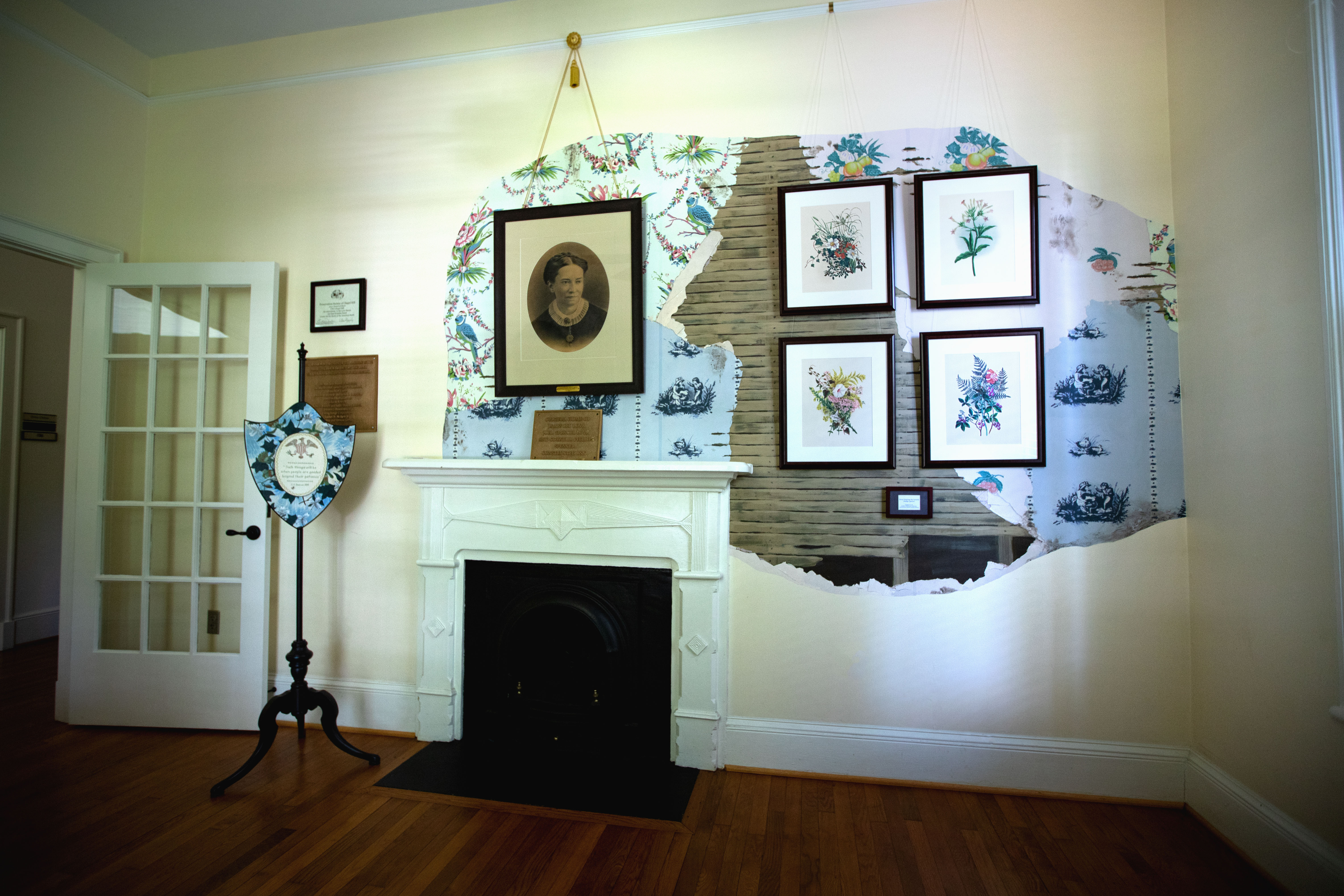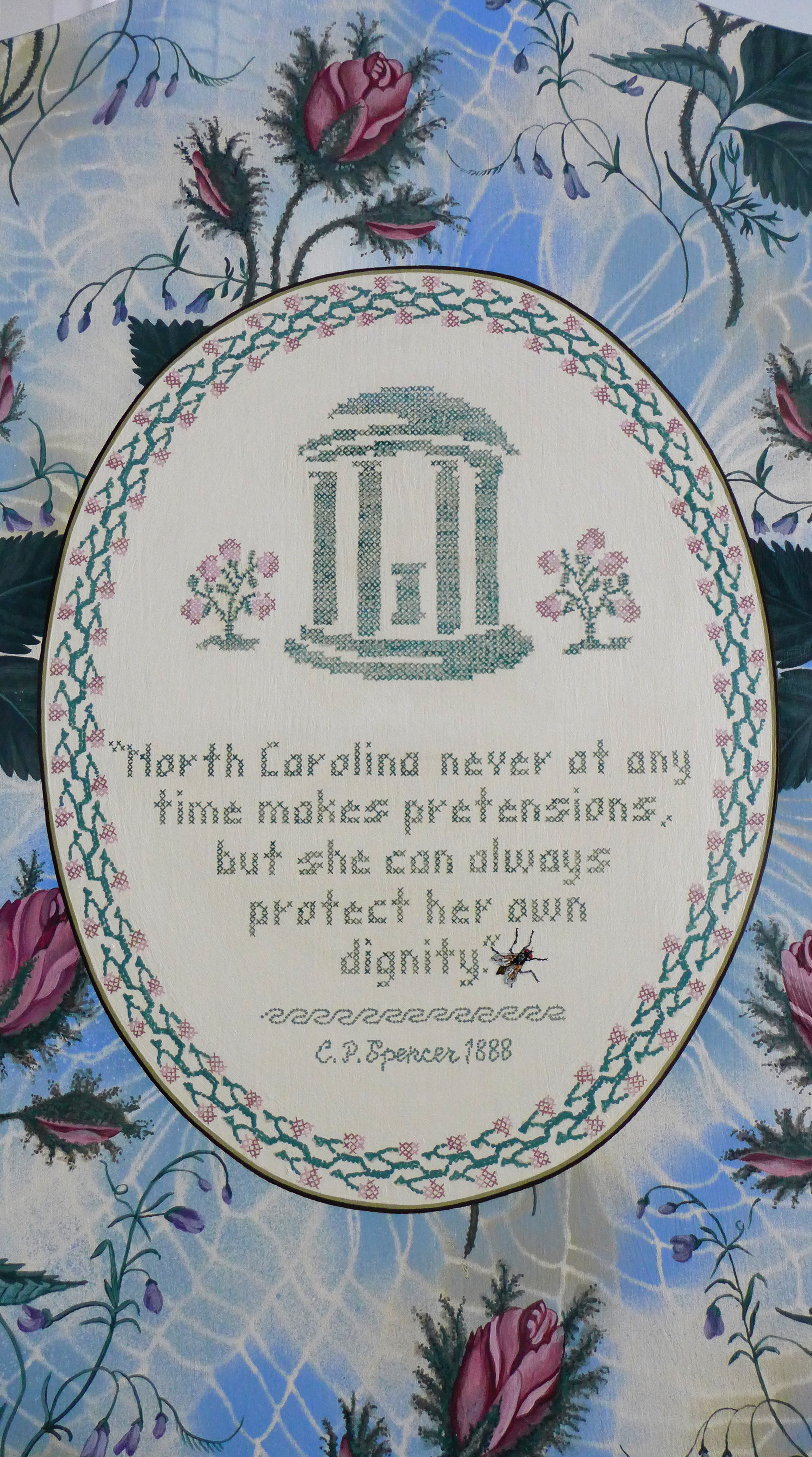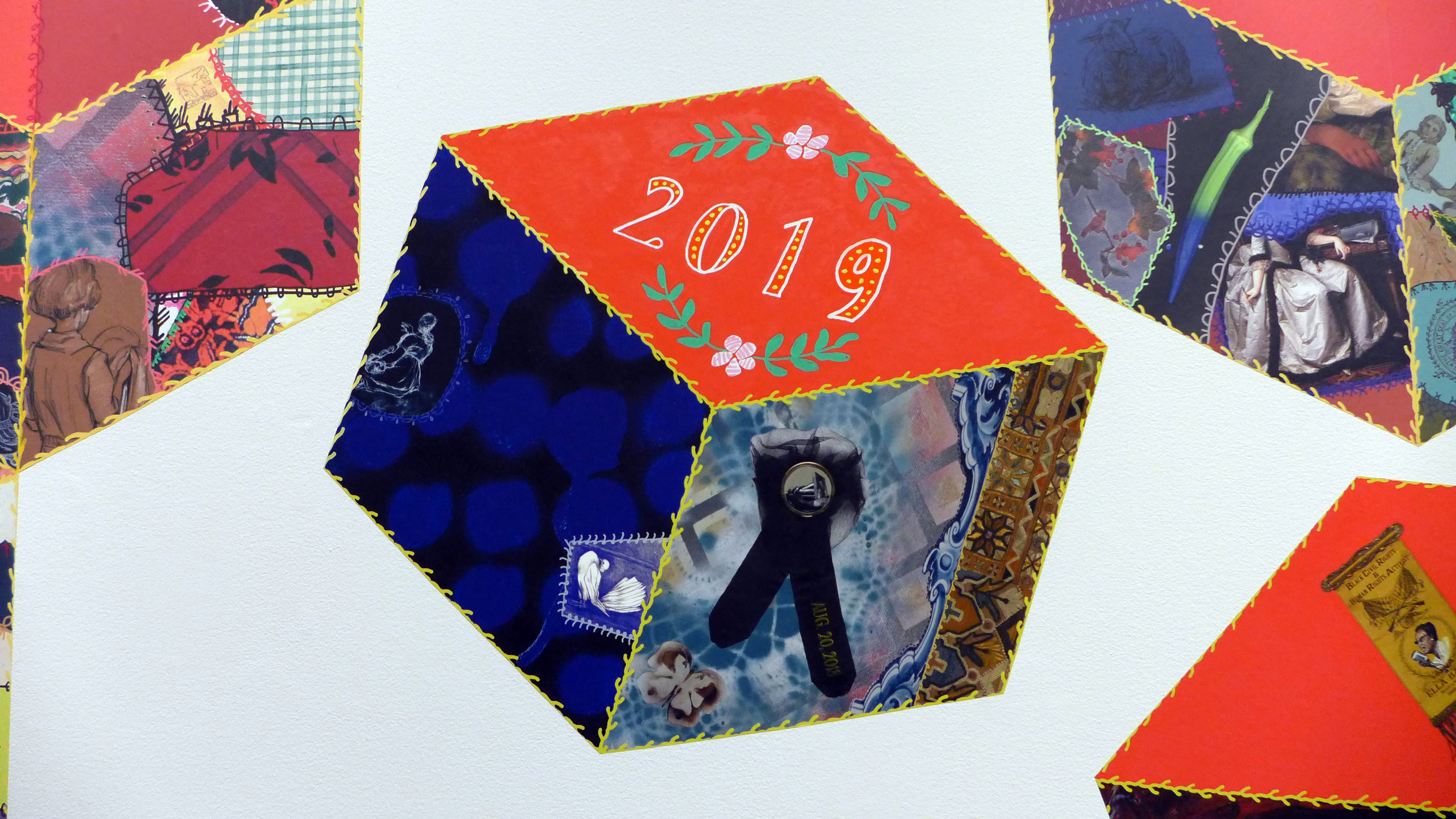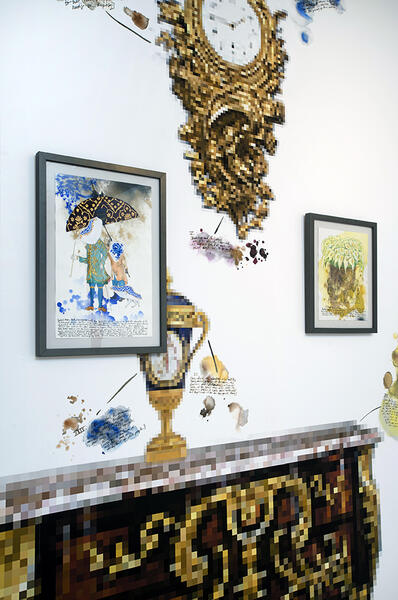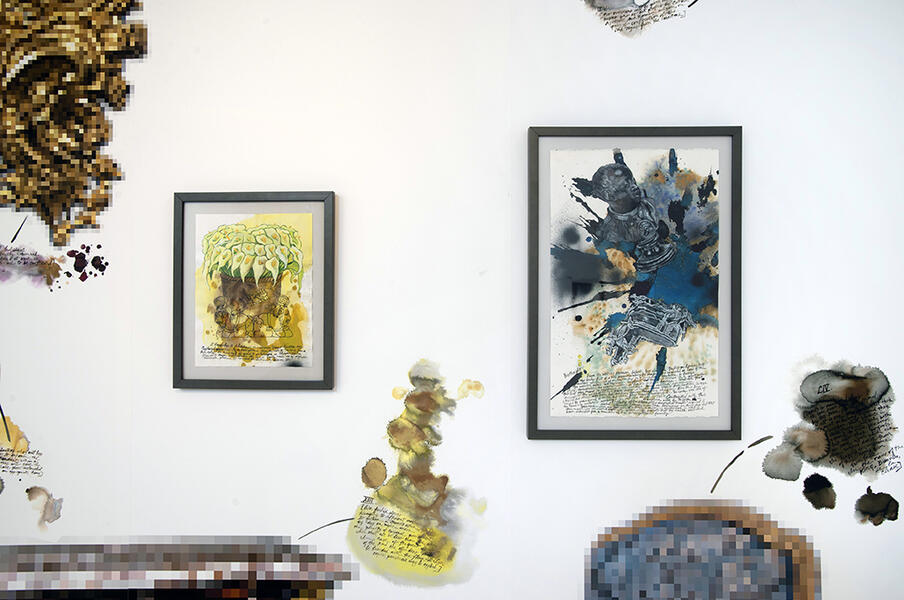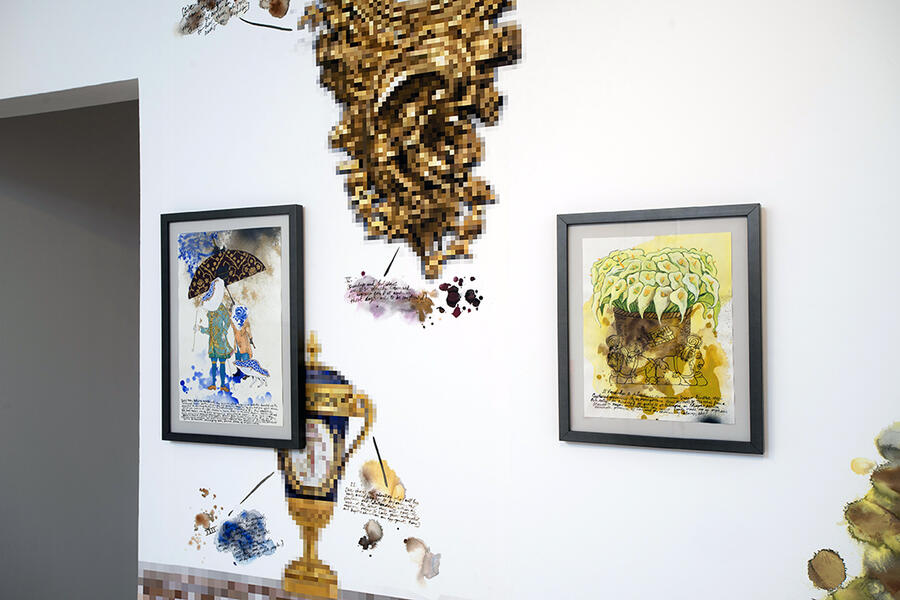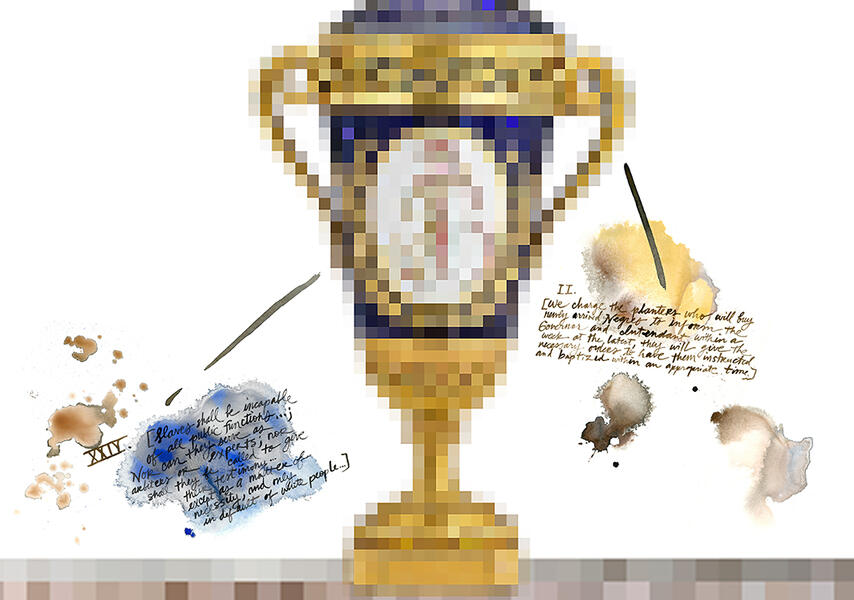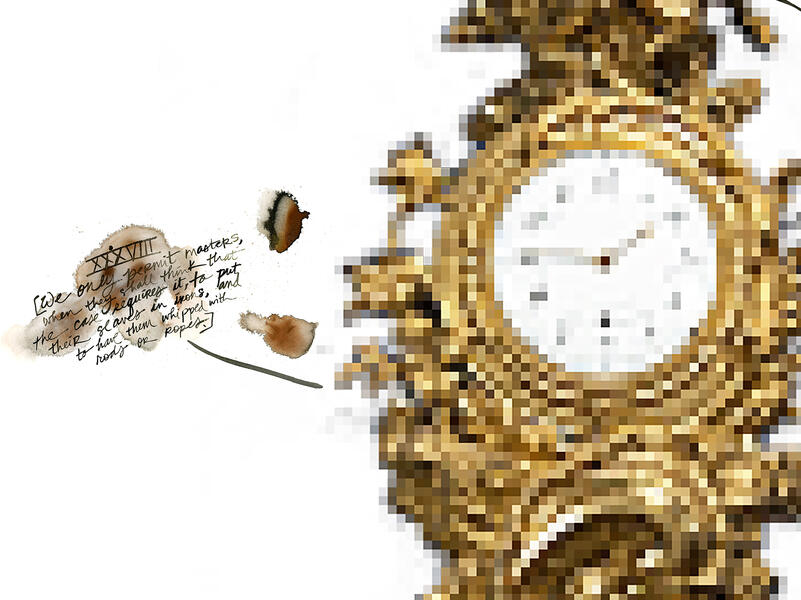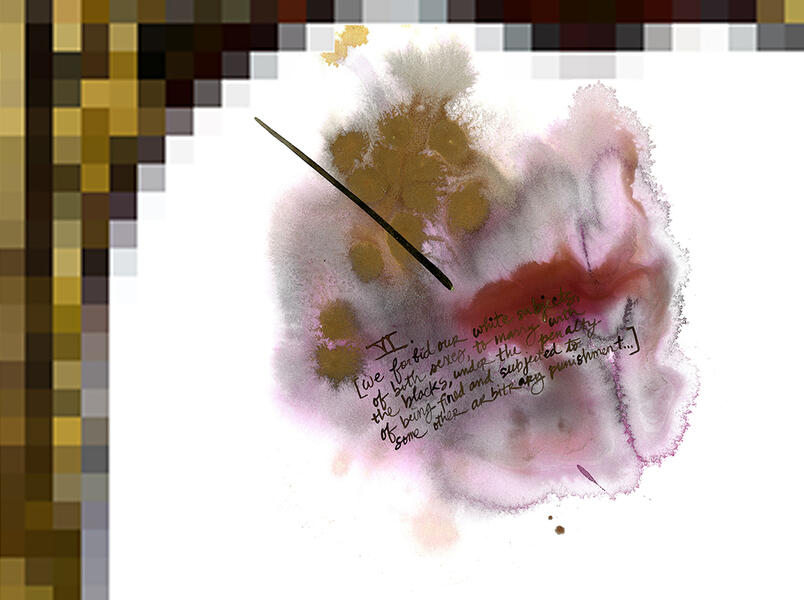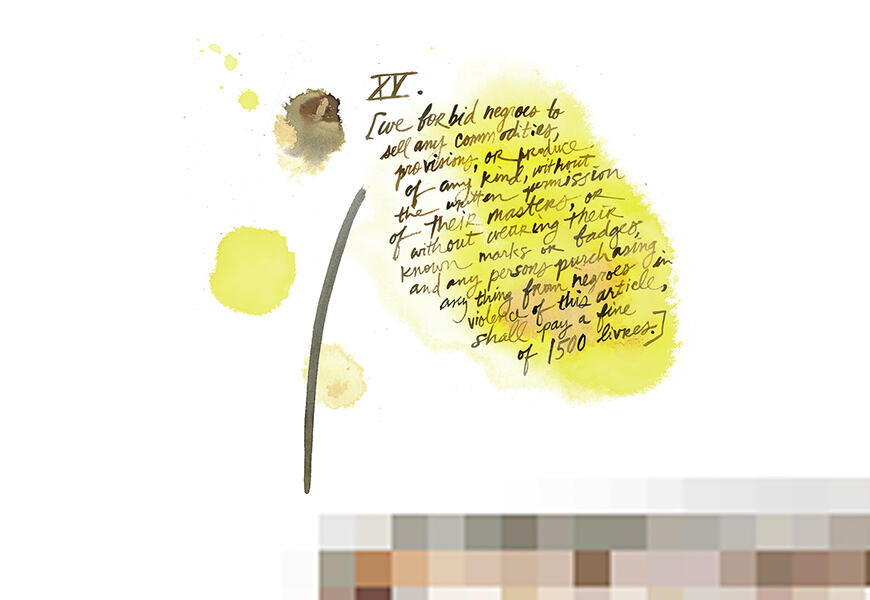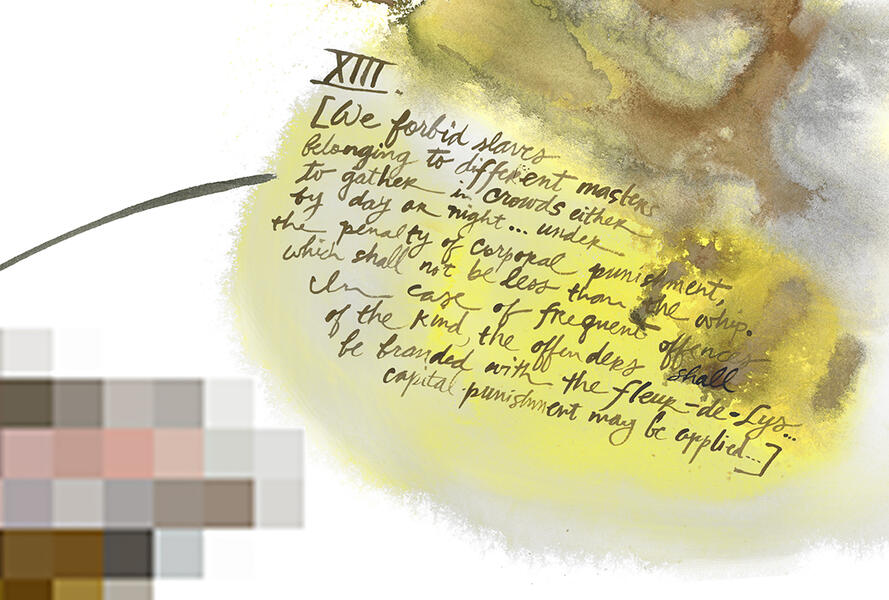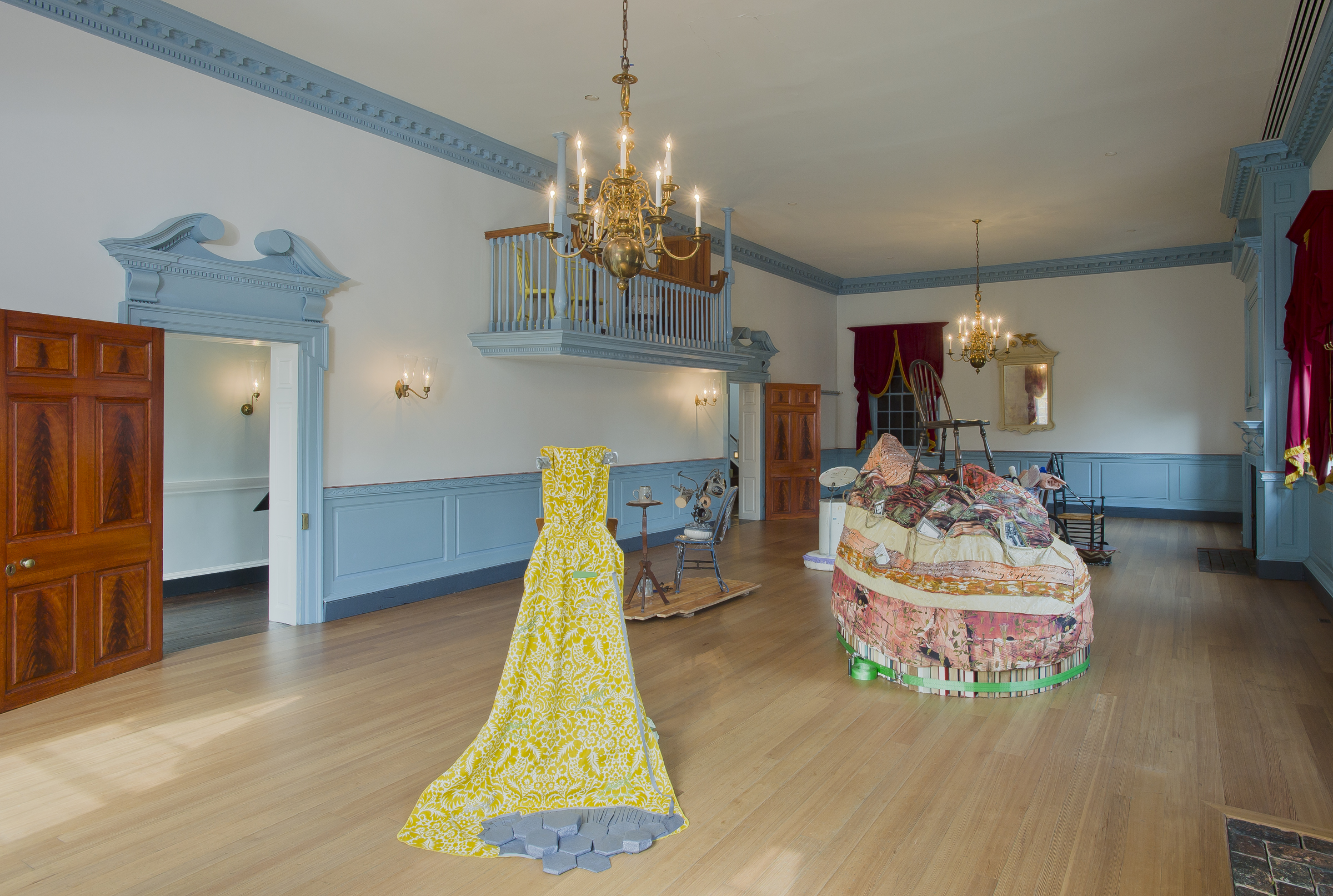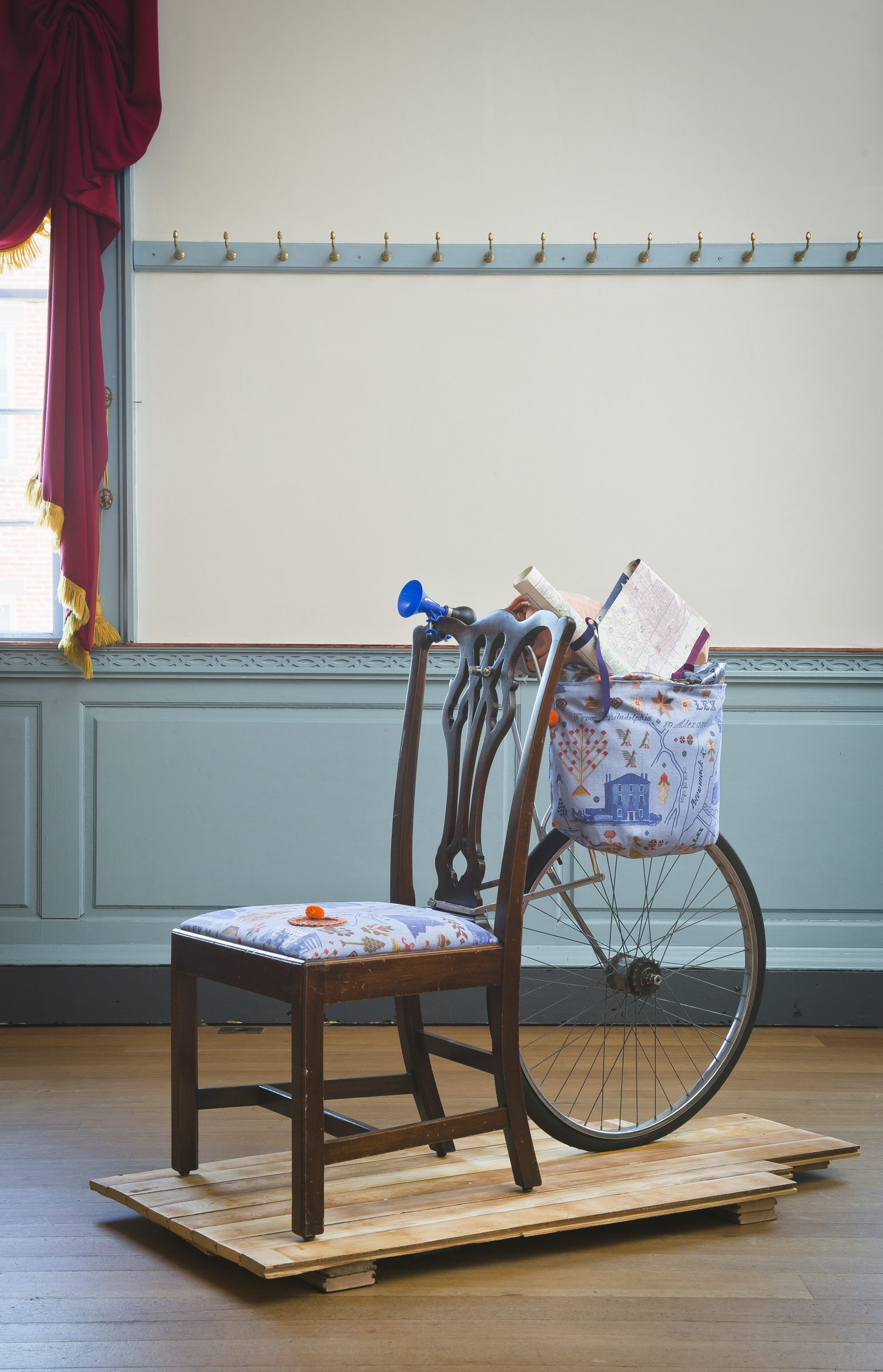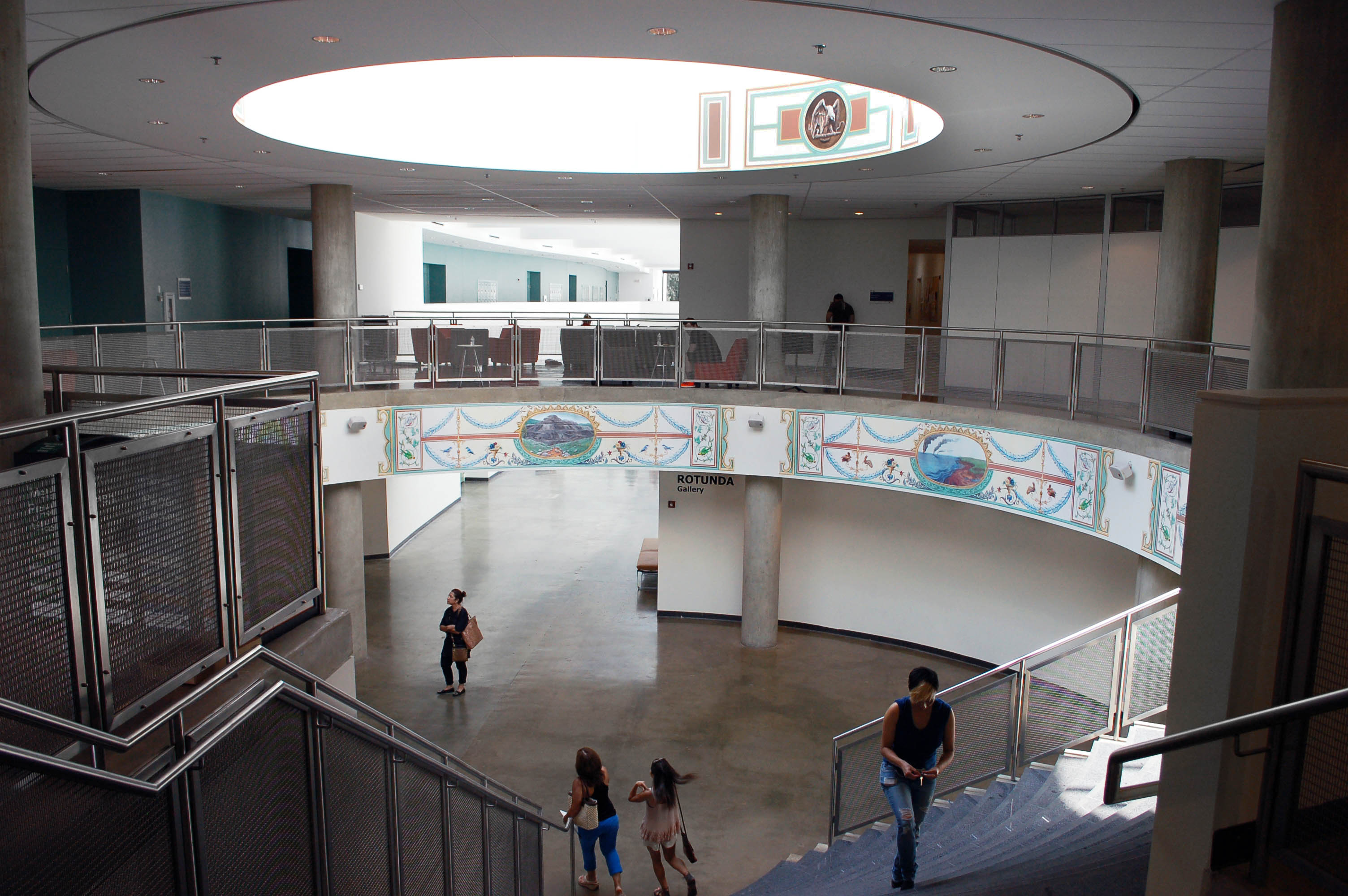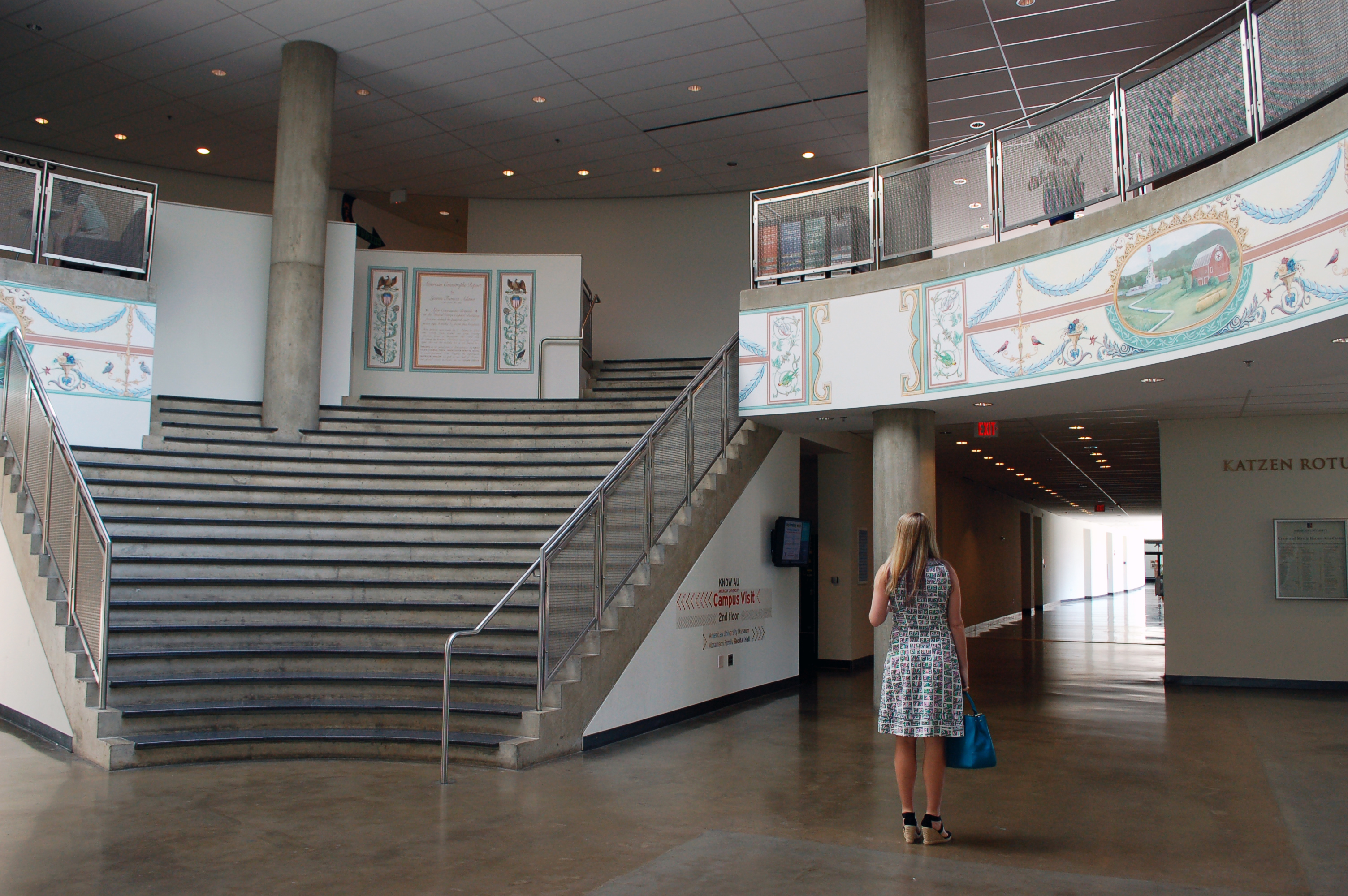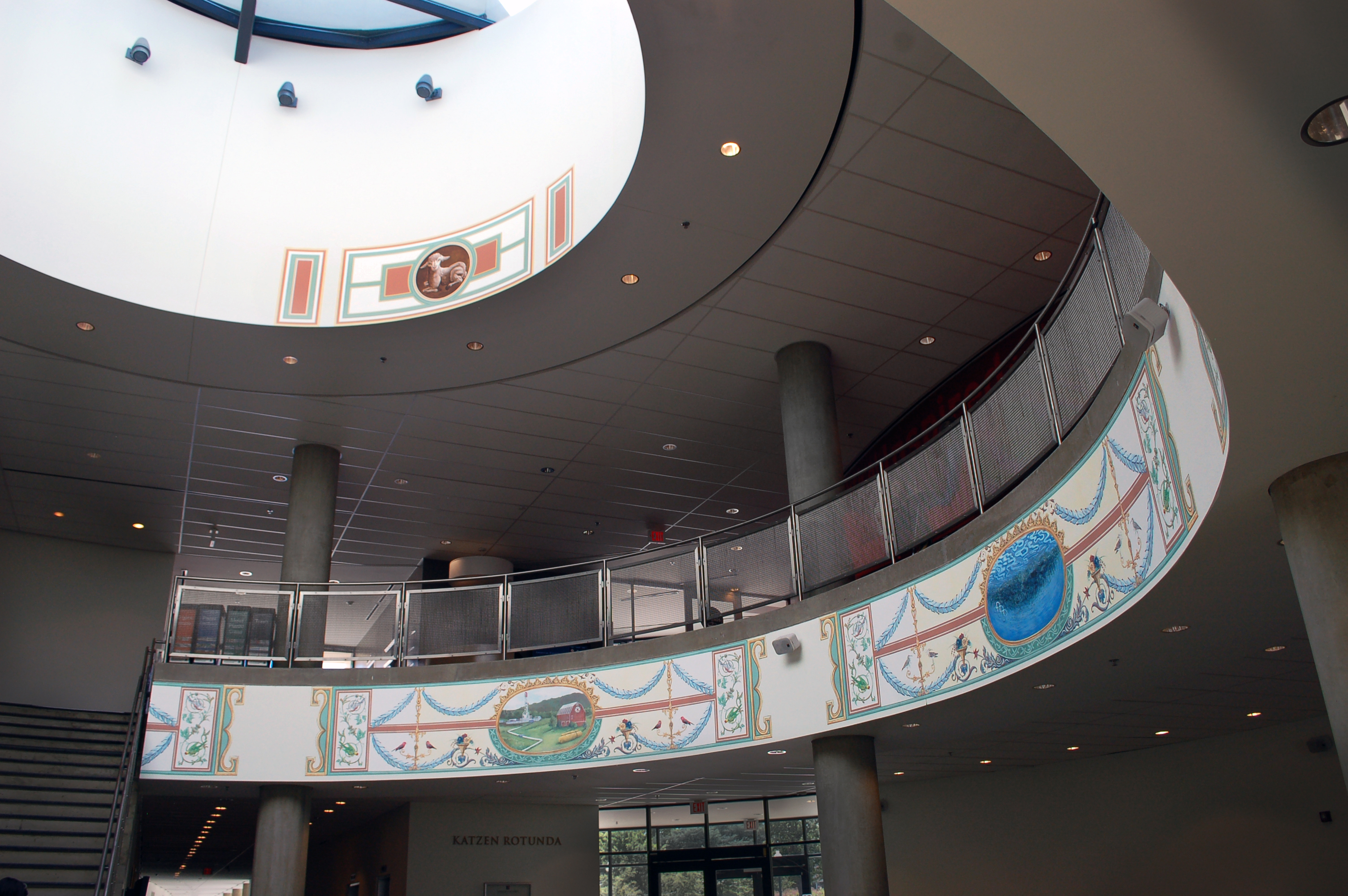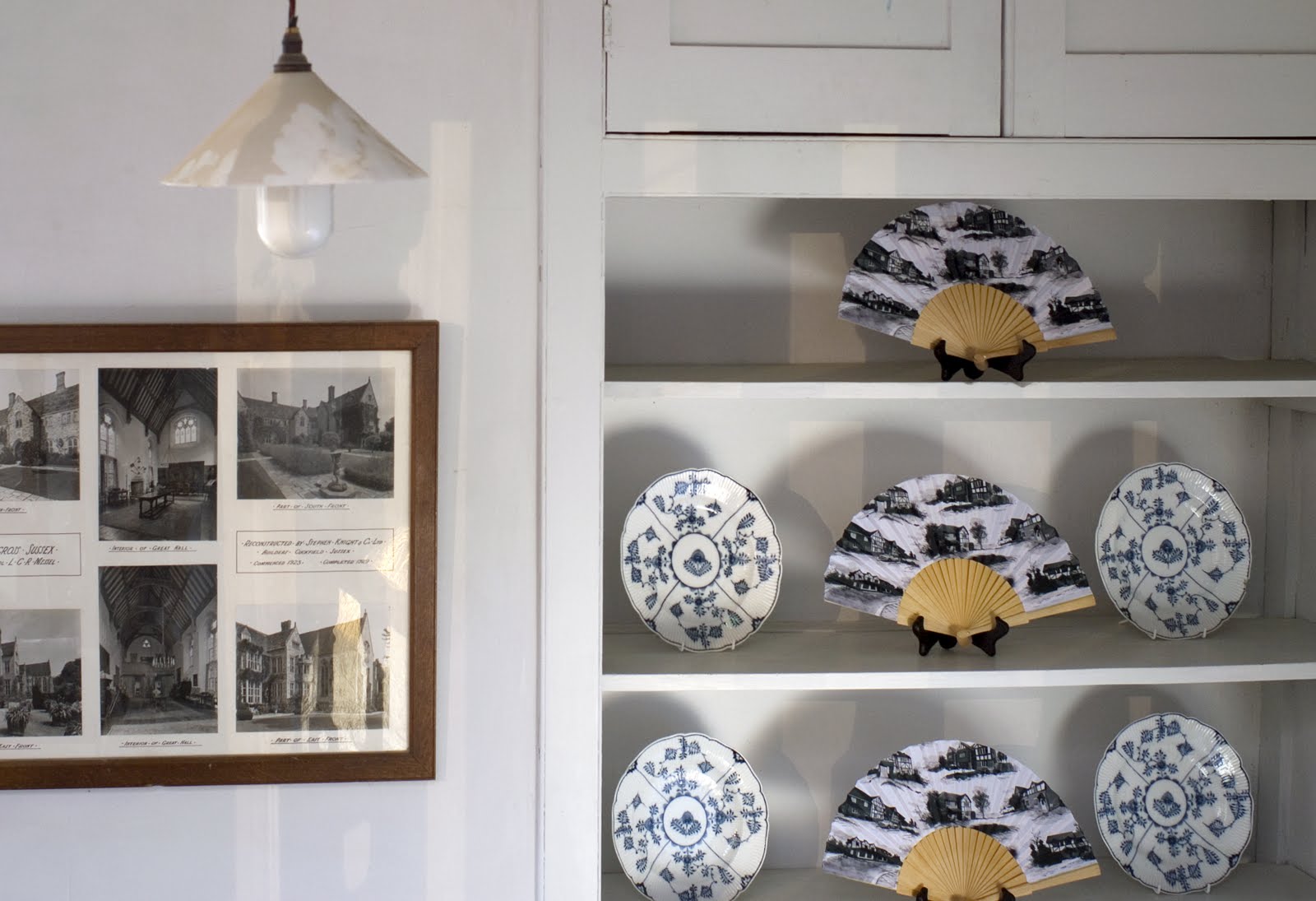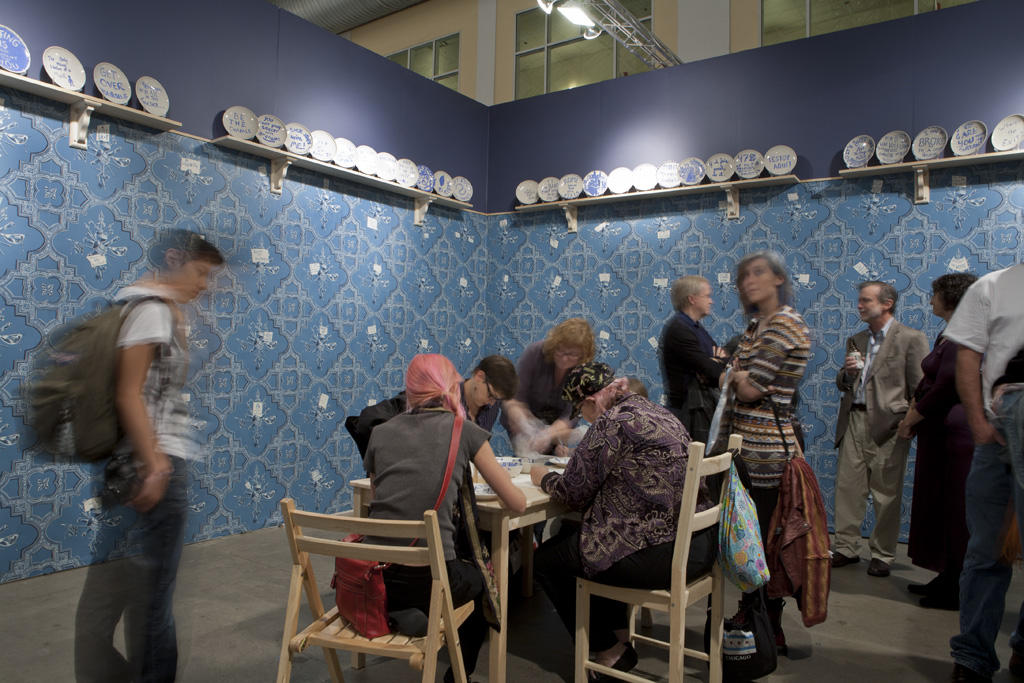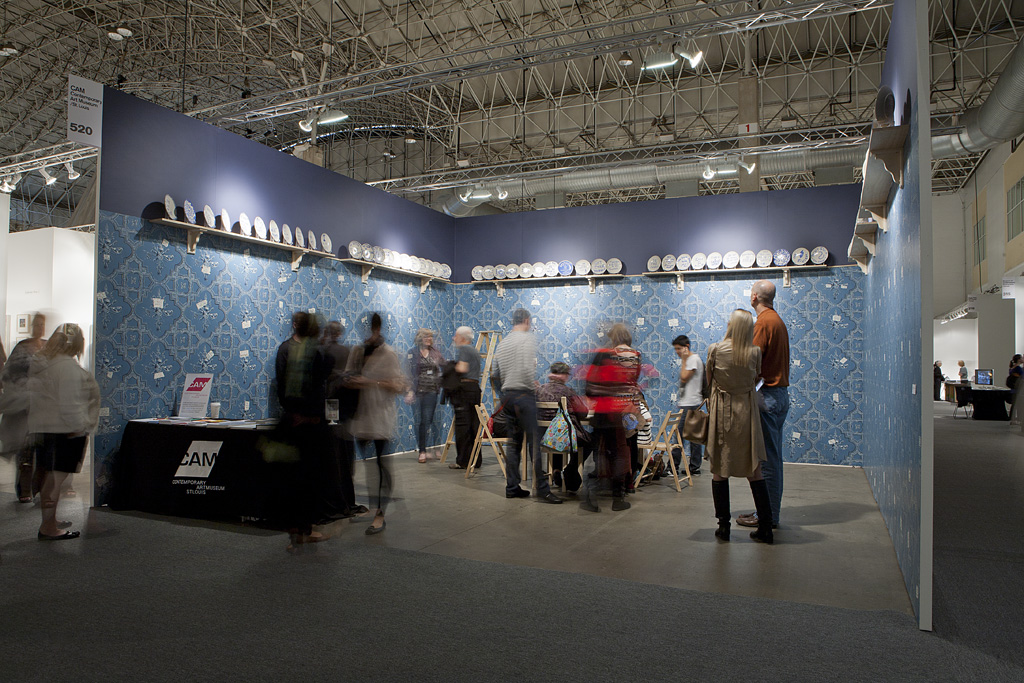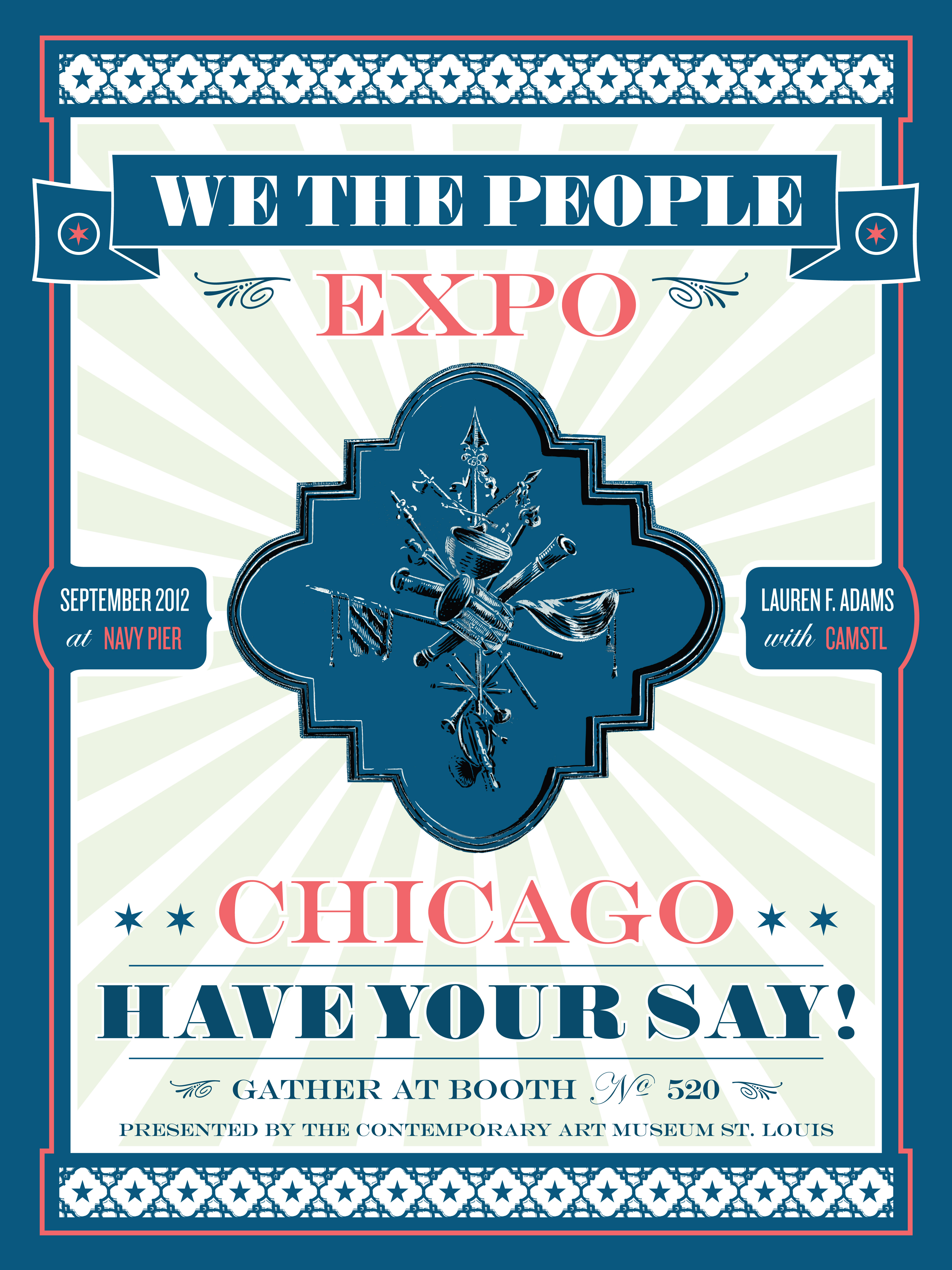Work samples
-
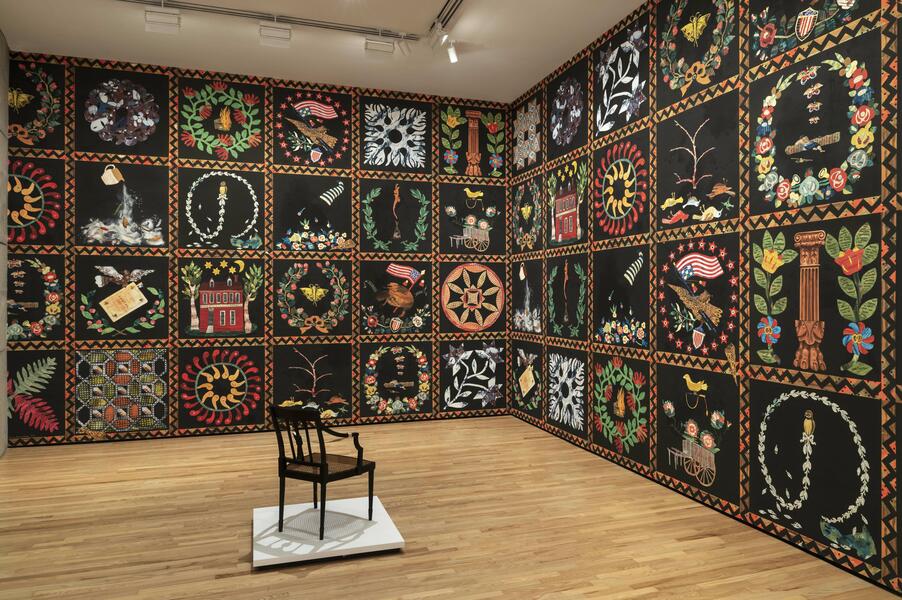 Forget-me-notForget-me-not 2021 36 feet long, 14 feet high Site-specific wallpaper with custom painted details, including 19th century painted Baltimore chair from the museum collection installed at the Baltimore Museum of Art November 2021 - April 2022 Installation view, All Due Respect, November 2021. The Baltimore Museum of Art, photo by Mitro Hood
Forget-me-notForget-me-not 2021 36 feet long, 14 feet high Site-specific wallpaper with custom painted details, including 19th century painted Baltimore chair from the museum collection installed at the Baltimore Museum of Art November 2021 - April 2022 Installation view, All Due Respect, November 2021. The Baltimore Museum of Art, photo by Mitro Hood -
 Crazy QuiltCrazy Quilt installation at the Ackland Art Museum, 31′ x 12′ custom wallpaper print 2018 - 2019 https://ackland.org/exhibition/art-lauren-frances-adams/ This wallpaper design appropriates from the historic American textile technique called crazy quilting. Quilting is a visual and conceptual framework for incorporating a variety of objects from the Ackland’s collection, UNC’s historical memorabilia collection, symbols of the state of North Carolina and references to state history, and my own personal statements. These myriad sources converge into a crazy quilt — a metaphor for the overlapping and sometimes seemingly disjunctive influences moving back and forth between the public and private sphere in our contemporary society. A particular emphasis is placed around images from the Ackland’s collection that feature women. Historic commemorative ribbons (memorializing the death of Lincoln or a 19th c. veterans’ gathering) offer a reworked framing device for elevating women’s history in North Carolina and at UNC.
Crazy QuiltCrazy Quilt installation at the Ackland Art Museum, 31′ x 12′ custom wallpaper print 2018 - 2019 https://ackland.org/exhibition/art-lauren-frances-adams/ This wallpaper design appropriates from the historic American textile technique called crazy quilting. Quilting is a visual and conceptual framework for incorporating a variety of objects from the Ackland’s collection, UNC’s historical memorabilia collection, symbols of the state of North Carolina and references to state history, and my own personal statements. These myriad sources converge into a crazy quilt — a metaphor for the overlapping and sometimes seemingly disjunctive influences moving back and forth between the public and private sphere in our contemporary society. A particular emphasis is placed around images from the Ackland’s collection that feature women. Historic commemorative ribbons (memorializing the death of Lincoln or a 19th c. veterans’ gathering) offer a reworked framing device for elevating women’s history in North Carolina and at UNC.
About Lauren

Lauren Frances Adams is a painter who lives and works in Baltimore. She earned her BFA at University of North Carolina-Chapel Hill, and her MFA at Carnegie Mellon University. She grew up in Snow Hill, North Carolina on a pig farm. Her work engages political and social histories through iconic images and domestic ornament. Her work has been exhibited across the United States at museums, university galleries, and artist-run spaces, with an upcoming 2021 project at the Baltimore… more
Forget-me-not
2021
36 feet long, 14 feet high
Site-specific wallpaper with custom painted details, including 19th century painted Baltimore chair from the museum collection installed at the Baltimore Museum of Art
November 2021 - April 2022
This wallpaper artwork fragments and reconnects elements from 19th century decorative objects in the Baltimore Museum of Art’s collection to explore difficult legacies from Baltimore City history, 1800-1850, when it was one of the largest cities in the country and the site of a busy port. Pointing specifically to Baltimore Album Quilts - textiles with a regionally distinct visual language -- and luxury furniture in the BMA’s collection produced for a powerful class of moneyed white Baltimore elites. Transforming and recombining multiple museum objects to expand aesthetic and narrative relationships across time (such as with the museum’s ancient Roman mosaics), this work highlights the limits and opportunities of collective memory in symbols of political and cultural importance.
This artwork was made by collaging painted and printed papers, scanning them, and digitally repeating them to form the patterned wallpaper. The painted colors and textures mimic the British and French imported fabrics typical of Baltimore Album Quilts of the period. Garlands that would typically feature a ship, monument, or bible instead now include moments from Baltimore history (such as a copy of Frances Ellen Watkins Harper’s publication, ‘Forest Leaves’), or from the BMA’s collection (such as a tiny moth from a Joshua Johnson painted portrait). Some blocks merge both history and museum object -- the wooden wardrobe made in 1830 by Quaker furnituremaker John Needles, monumentalized to replace the Washington monument in Baltimore, with his memoir’s activist remembrances blooming into a frame of flowers for the enlarged carved paw of the furniture’s base. Other blocks gather artifacts such as a British-made abolitionist jug on display elsewhere in the museum, spilling feathers found in various artworks located in the same gallery. Birds become liberated, deformed, or expired; moths wave flags of mourning, and abundant cornucopias shake until empty. Grief and loss, as well as hope and despair, are common themes in response to the bright and lively Baltimore Album Quilt inspirations.
Spolia:
The Spolia paintings fragment numerous neoclassical decorative schema found in Baltimore Painted Furniture, such as scrolls, swags, stripes and bows, as well as mythical fauna and trophies. On each small painting is an actual section of a wooden chair, from two chairs I found in my alley. I wanted to incorporate a physical reference to my neighborhood, similar to the chairs that served as inspiration in the BMA’s collection, and fortuitously found it literally in my own backyard. This white-painted furniture foregrounds the idea of erasure amid an excess of decoration. The 19th century mirror has a bold, imposing eagle at its apex. The mirror’s authoritative form and typical use as an object to reflect a room and its inhabitants is affirmed and subverted: In this case, the mirror is hung very high and will not reflect the visitors in the gallery, which is also a kind of commentary on reckoning with the places and things protected by an incomplete American history.
Installation view, All Due Respect, November 2021. The Baltimore Museum of Art, photo by Mitro Hood
-
 Forget-me-notForget-me-not 2021 36 feet long, 14 feet high Site-specific wallpaper with custom painted details, including 19th century painted Baltimore chair from the museum collection installed at the Baltimore Museum of Art November 2021 - April 2022 Installation view, All Due Respect, November 2021. The Baltimore Museum of Art, photo by Mitro Hood
Forget-me-notForget-me-not 2021 36 feet long, 14 feet high Site-specific wallpaper with custom painted details, including 19th century painted Baltimore chair from the museum collection installed at the Baltimore Museum of Art November 2021 - April 2022 Installation view, All Due Respect, November 2021. The Baltimore Museum of Art, photo by Mitro Hood -
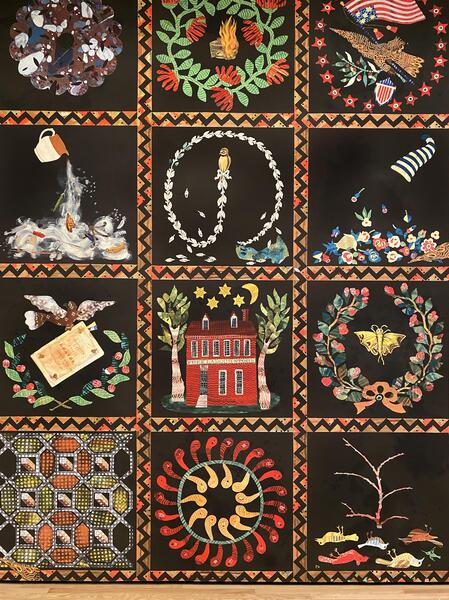 Forget-me-notForget-me-not 2021 36 feet long, 14 feet high Site-specific wallpaper with custom painted details, including 19th century painted Baltimore chair from the museum collection installed at the Baltimore Museum of Art November 2021 - April 2022
Forget-me-notForget-me-not 2021 36 feet long, 14 feet high Site-specific wallpaper with custom painted details, including 19th century painted Baltimore chair from the museum collection installed at the Baltimore Museum of Art November 2021 - April 2022 -
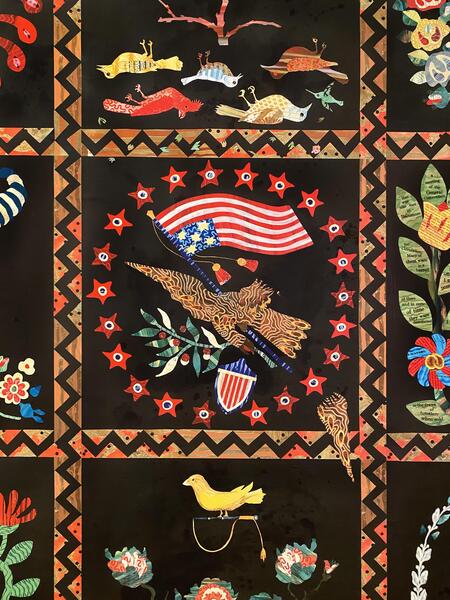 Forget-me-not
Forget-me-not -
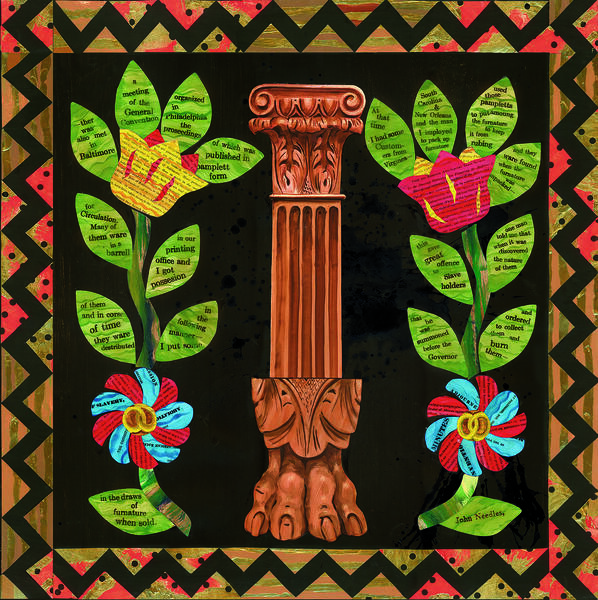 Forget-me-not
Forget-me-not -
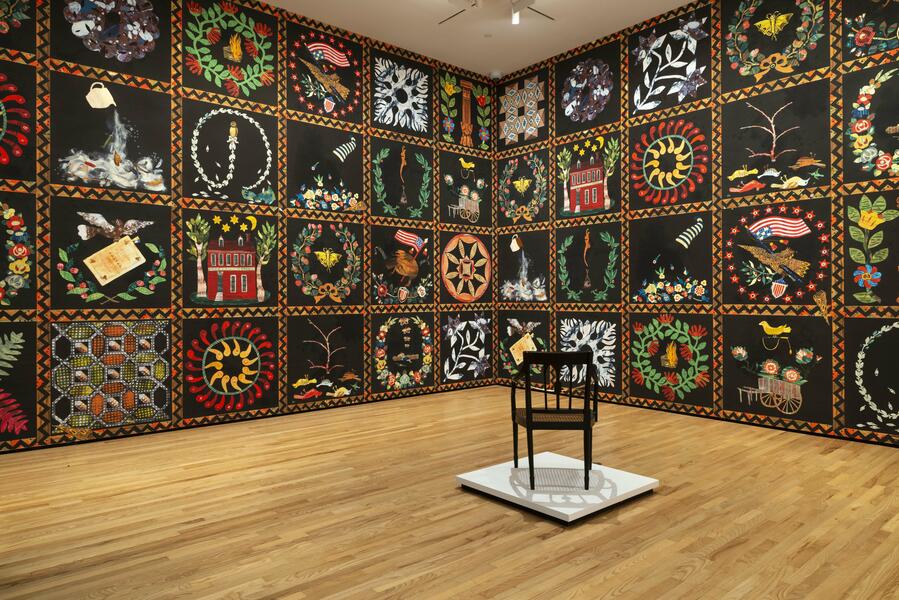 Forget-me-notForget-me-not 2021 36 feet long, 14 feet high Site-specific wallpaper with custom painted details, including 19th century painted Baltimore chair from the museum collection installed at the Baltimore Museum of Art November 2021 - April 2022
Forget-me-notForget-me-not 2021 36 feet long, 14 feet high Site-specific wallpaper with custom painted details, including 19th century painted Baltimore chair from the museum collection installed at the Baltimore Museum of Art November 2021 - April 2022 -
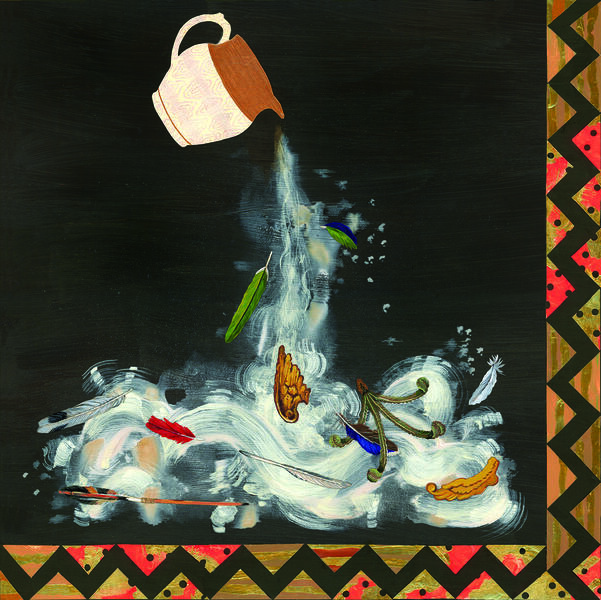 Forget-me-notForget-me-not 2021 36 feet long, 14 feet high Site-specific wallpaper with custom painted details, including 19th century painted Baltimore chair from the museum collection installed at the Baltimore Museum of Art November 2021 - April 2022
Forget-me-notForget-me-not 2021 36 feet long, 14 feet high Site-specific wallpaper with custom painted details, including 19th century painted Baltimore chair from the museum collection installed at the Baltimore Museum of Art November 2021 - April 2022 -
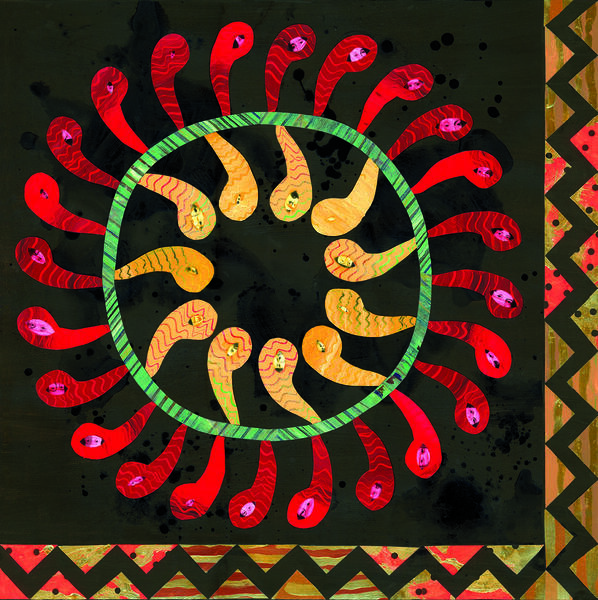 Forget-me-notForget-me-not 2021 36 feet long, 14 feet high Site-specific wallpaper with custom painted details, including 19th century painted Baltimore chair from the museum collection installed at the Baltimore Museum of Art November 2021 - April 2022
Forget-me-notForget-me-not 2021 36 feet long, 14 feet high Site-specific wallpaper with custom painted details, including 19th century painted Baltimore chair from the museum collection installed at the Baltimore Museum of Art November 2021 - April 2022 -
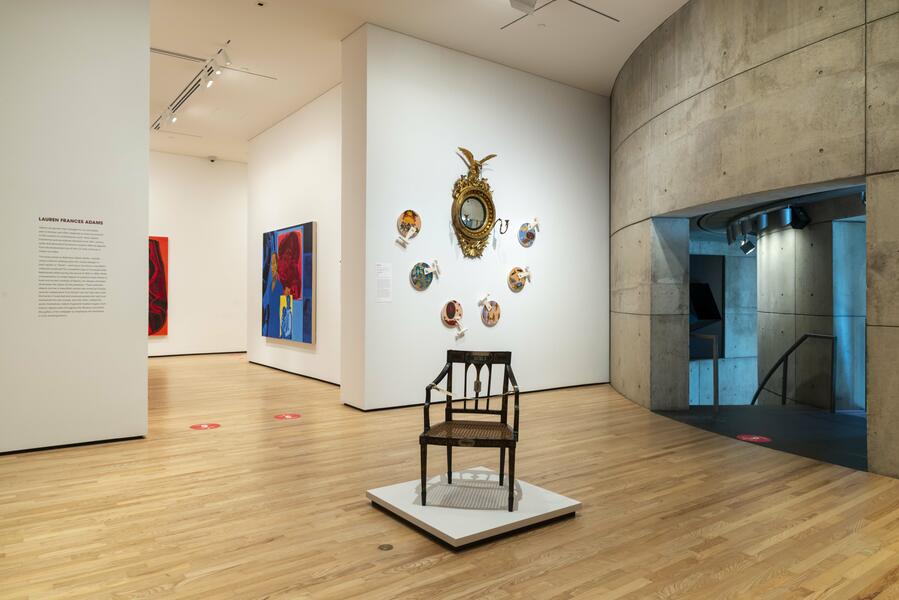 Installation view
Installation view -
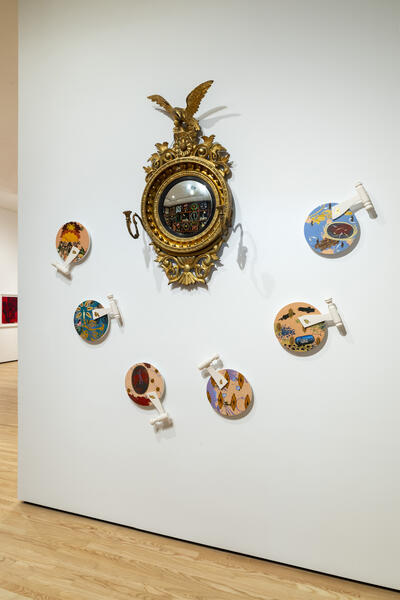 SpoliaSpolia 2021 6 paintings approximately 16” x 16” each Acrylic, found wooden chair fragment, and gold leaf 6 paintings and a 19th century mirror from museum collection installed at the Baltimore Museum of Art November 2021 - April 2022
SpoliaSpolia 2021 6 paintings approximately 16” x 16” each Acrylic, found wooden chair fragment, and gold leaf 6 paintings and a 19th century mirror from museum collection installed at the Baltimore Museum of Art November 2021 - April 2022 -
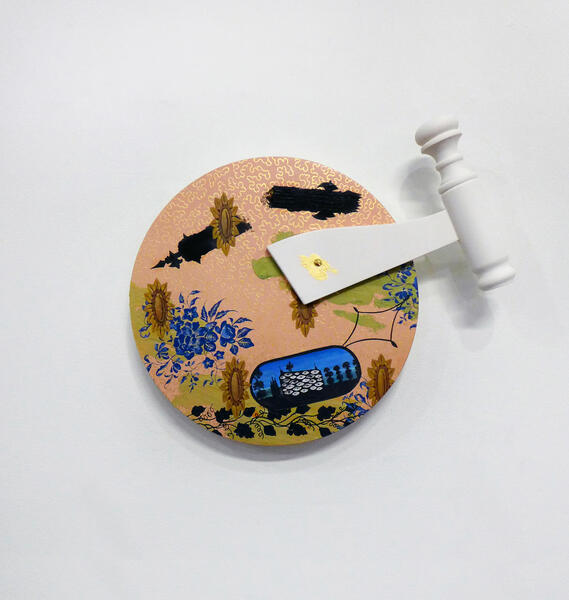 Spolia #5Spolia 2021 6 paintings approximately 16” x 16” each Acrylic, found wooden chair fragment, and gold leaf 6 paintings and a 19th century mirror from museum collection installed at the Baltimore Museum of Art November 2021 - April 2022
Spolia #5Spolia 2021 6 paintings approximately 16” x 16” each Acrylic, found wooden chair fragment, and gold leaf 6 paintings and a 19th century mirror from museum collection installed at the Baltimore Museum of Art November 2021 - April 2022
In faithful remembrance of Cornelia Phillips Spencer, and to the truth-loving people of North Carolina
This site-specific public art project on view from 2020 - 2021 at the Center for the Study of the American South intervenes throughout CSAS’ location in a historic home on the campus of the University of North Carolina at Chapel Hill. The installation encompasses sculptures that evoke the historic fire screens found in house museums from the antebellum era in the United States, as well as a wallpaper display that depicts an illusory excavation into the walls of the building.
CSAS’ offices are located in a renovated building that is the former home of Cornelia Phillips Spencer. Spencer is a well-known figure on UNC’s campus. She was a White woman who was active as an author and historian in the mid-to-late 19th century in Chapel Hill. Her copious writings evince White supremacist and patriarchal beliefs. Her influence on the university was intertwined with her political activism that advanced Lost Cause Confederate mythology in the postbellum era. Her segregationist beliefs initially helped close the University for a period. Her impact has had a strong presence on campus in the 20th century, with a campus dorm named for her.
Despite the repeated calls to remove Spencer from an honorific position in campus memory, a portrait of Spencer, along with reproductions of several of her botanical watercolors, hang in the main parlor of the CSAS offices. My project takes on the complex and troubling endowment of Cornelia Phillips Spencer, weaving together Spencer’s own words as irrefutable evidence in the persistent lineage of perpetual racism and sexism in the University’s official actions in our present day.
The painted sculptures are distributed throughout the Center for the Study of the American South’s building, in front of the 5 fireplaces extant today. Historic fire screens were domestic objects typically made of wood or metal that assist in regulating the warmth of a parlor fire for those seated nearby. Fire screens often feature precious paintings and embroidery, often by upper middle class young women, as a display of their technical skill and trained virtuosity. Pastoral scenes and decorative patterns were common visual themes, and the fire screens I made for ‘Imagining UNC’s Future with Art,’ recycle appropriations of Spencer’s own floral paintings (held in the Southern Historical Collection of Wilson Library at UNC) as backdrops for embroidered texts
Full text and documentation can be found at: https://imaginingfuture.unc.edu/
-
 In Faithful Remembrance. . .In faithful remembrance of Cornelia Phillips Spencer, and to the truth-loving people of North Carolina Site-specific public art installation at the Center for the Study of the American South, Chapel Hill, North Carolina 2020 - 2021
In Faithful Remembrance. . .In faithful remembrance of Cornelia Phillips Spencer, and to the truth-loving people of North Carolina Site-specific public art installation at the Center for the Study of the American South, Chapel Hill, North Carolina 2020 - 2021 -
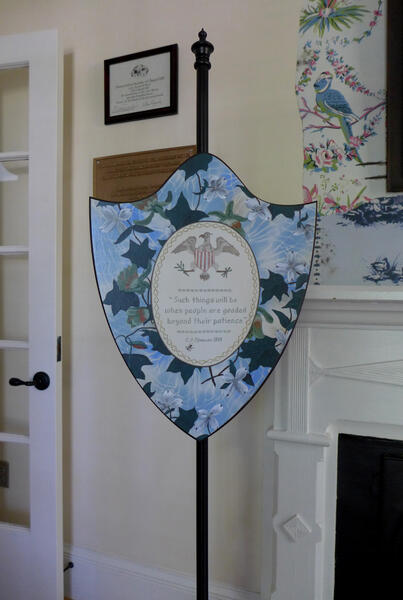 In Faithful Remembrance. . .
In Faithful Remembrance. . . -
In Faithful Remembrance. . .
-
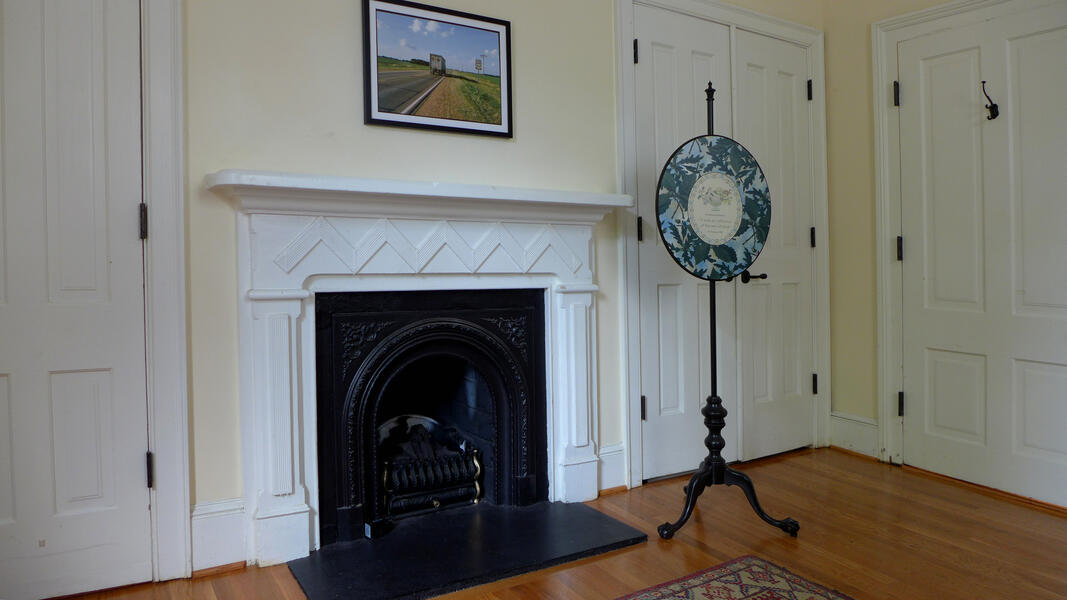 In Faithful Remembrance. . .
In Faithful Remembrance. . . -
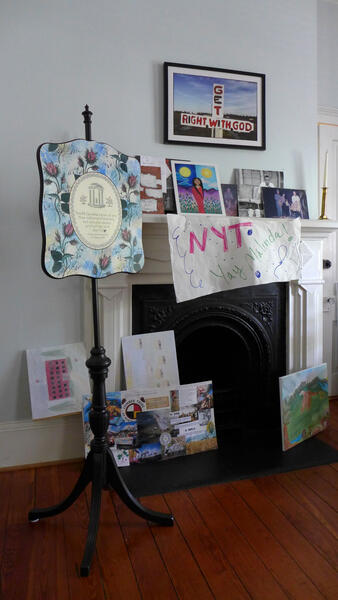 In Faithful Remembrance. . .
In Faithful Remembrance. . . -
 In Faithful Remembrance. . .
In Faithful Remembrance. . . -
In Faithful Remembrance. . .
-
In Faithful Remembrance. . .
-
In Faithful Remembrance. . .
-
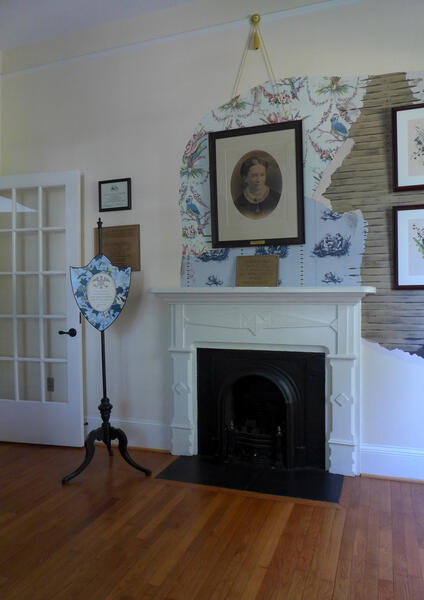 In Faithful Remembrance. . .
In Faithful Remembrance. . .
Crazy Quilt
contemporary society. A particular emphasis is placed around images from the Ackland’s collection that feature women. Historic commemorative ribbons (memorializing the death of Lincoln or a 19th c. veterans’ gathering) offer a reworked framing device for elevating women’s history in North Carolina and at UNC.
-
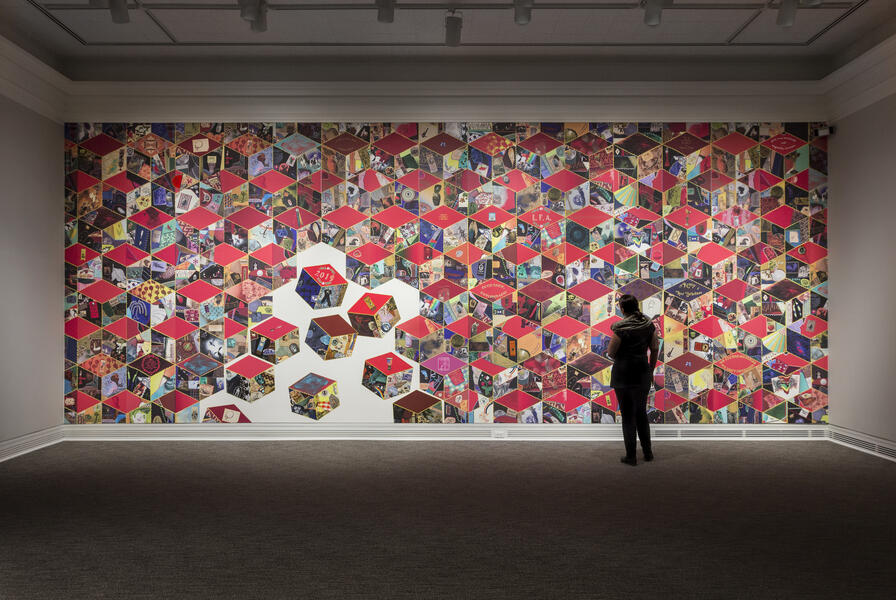 Crazy Quilt(Photo by Diane Davis Photo) Crazy Quilt installation at the Ackland Art Museum, 31′ x 12′ custom wallpaper print
Crazy Quilt(Photo by Diane Davis Photo) Crazy Quilt installation at the Ackland Art Museum, 31′ x 12′ custom wallpaper print -
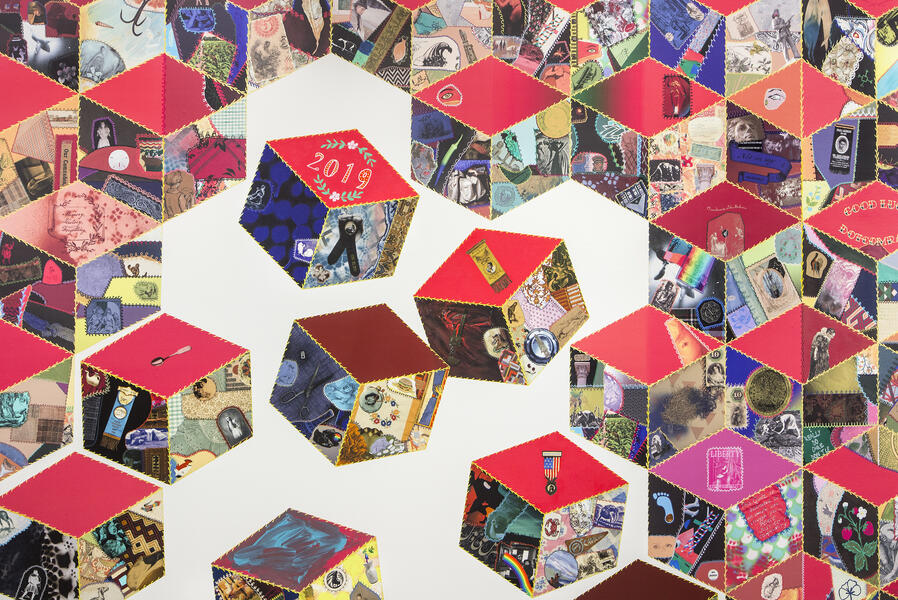 Crazy Quilt(Photo by Diane Davis Photo) Crazy Quilt installation at the Ackland Art Museum, 31′ x 12′ custom wallpaper print
Crazy Quilt(Photo by Diane Davis Photo) Crazy Quilt installation at the Ackland Art Museum, 31′ x 12′ custom wallpaper print -
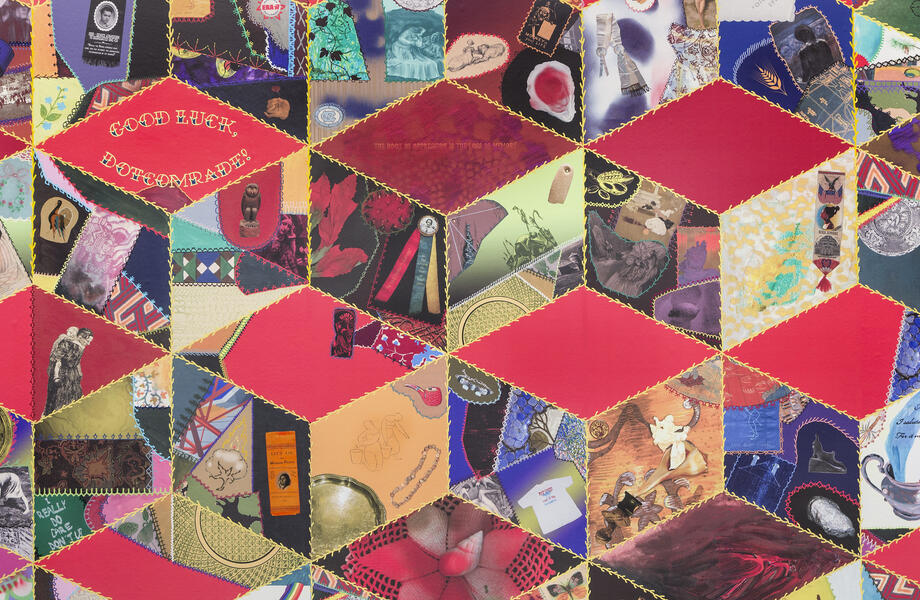 Crazy Quilt(Photo by Diane Davis Photo) Crazy Quilt installation at the Ackland Art Museum, 31′ x 12′ custom wallpaper print
Crazy Quilt(Photo by Diane Davis Photo) Crazy Quilt installation at the Ackland Art Museum, 31′ x 12′ custom wallpaper print -
 Crazy QuiltCrazy Quilt installation at the Ackland Art Museum, 31′ x 12′ custom wallpaper print
Crazy QuiltCrazy Quilt installation at the Ackland Art Museum, 31′ x 12′ custom wallpaper print -
 Crazy QuiltCrazy Quilt installation at the Ackland Art Museum, 31′ x 12′ custom wallpaper print
Crazy QuiltCrazy Quilt installation at the Ackland Art Museum, 31′ x 12′ custom wallpaper print -
 Crazy QuiltCrazy Quilt installation at the Ackland Art Museum, 31′ x 12′ custom wallpaper print
Crazy QuiltCrazy Quilt installation at the Ackland Art Museum, 31′ x 12′ custom wallpaper print -
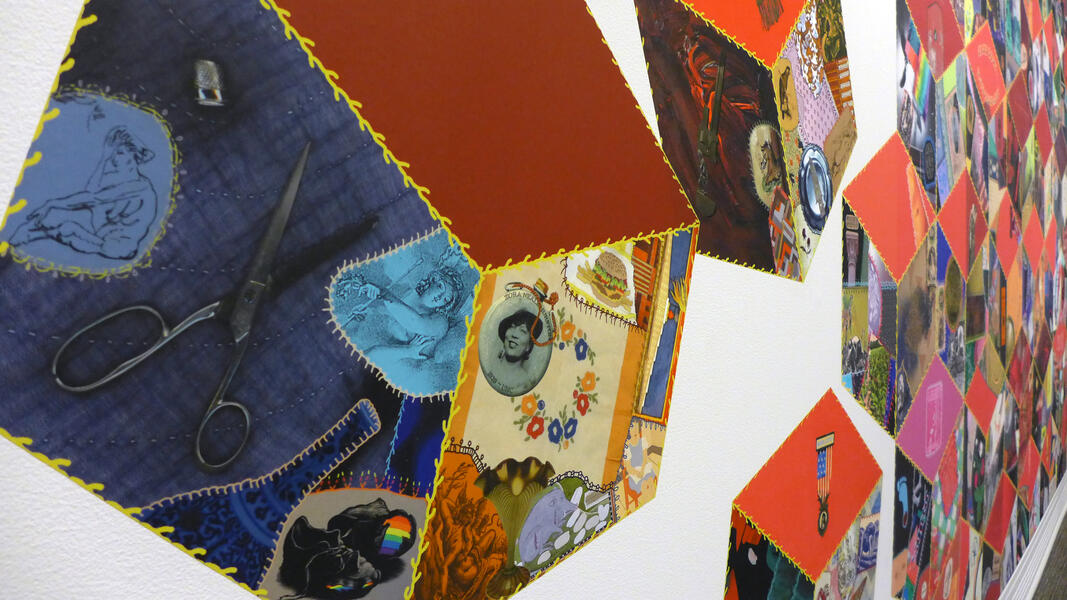 Crazy QuiltCrazy Quilt installation at the Ackland Art Museum, 31′ x 12′ custom wallpaper print
Crazy QuiltCrazy Quilt installation at the Ackland Art Museum, 31′ x 12′ custom wallpaper print -
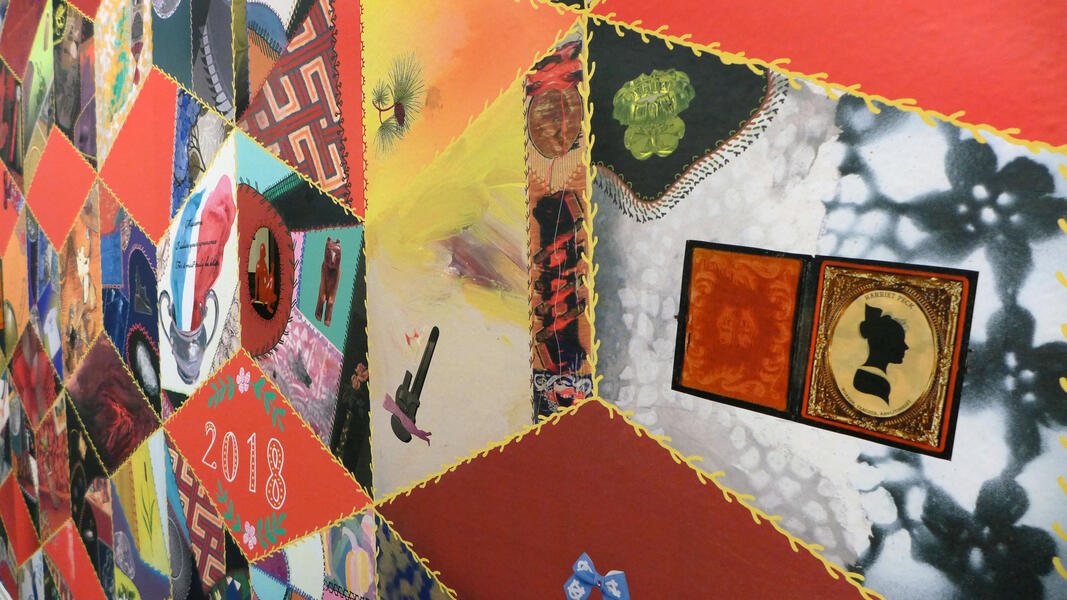 Crazy QuiltCrazy Quilt installation at the Ackland Art Museum, 31′ x 12′ custom wallpaper print
Crazy QuiltCrazy Quilt installation at the Ackland Art Museum, 31′ x 12′ custom wallpaper print -
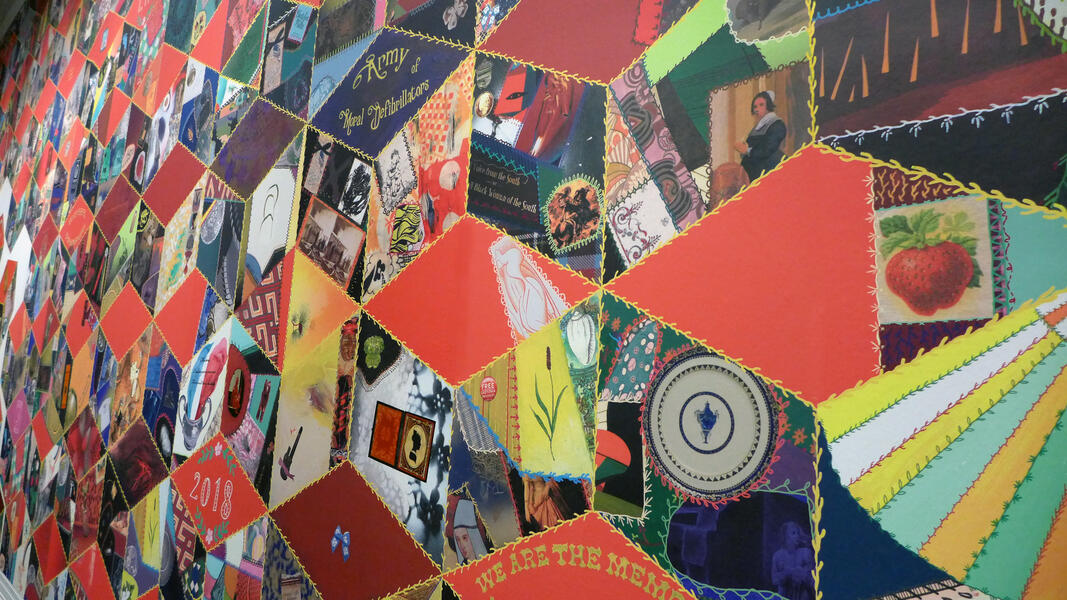 Crazy QuiltCrazy Quilt installation at the Ackland Art Museum, 31′ x 12′ custom wallpaper print
Crazy QuiltCrazy Quilt installation at the Ackland Art Museum, 31′ x 12′ custom wallpaper print -
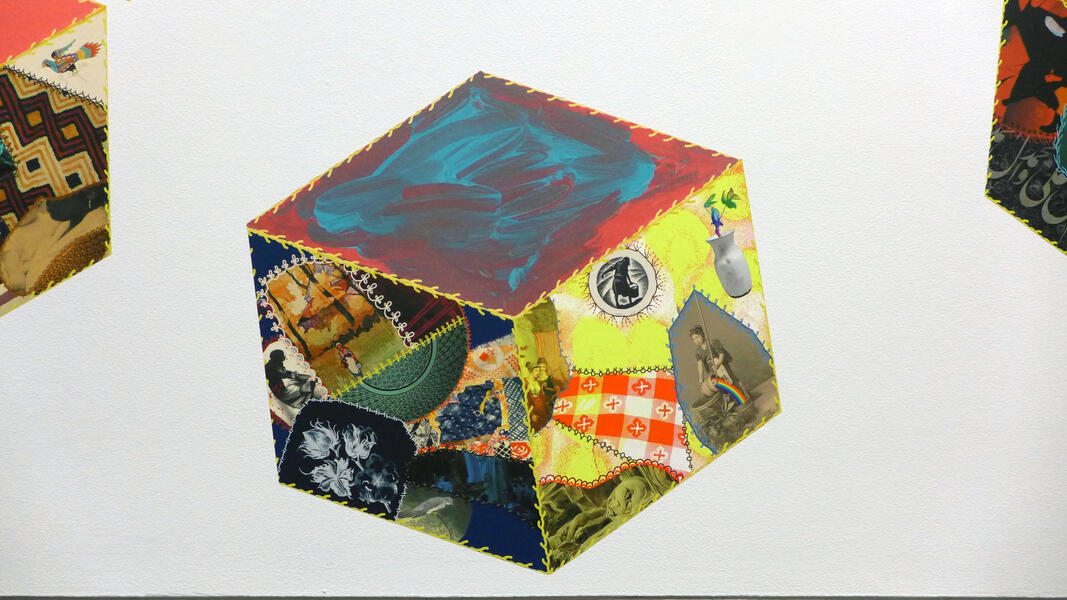 Crazy QuiltCrazy Quilt installation at the Ackland Art Museum, 31′ x 12′ custom wallpaper print
Crazy QuiltCrazy Quilt installation at the Ackland Art Museum, 31′ x 12′ custom wallpaper print
Germinal
-
 Jackson-Lee MonumentJACKSON-LEE MONUMENT Acrylic on birch wood panels, 2018 Foreground: ‘Still Life with Fruit and Nuts’ by Robert Duncanson (1848) with speculative offering left at the monument after its removal Background: Celebrants at the Jackson Lee Monument pedestal in August 2017, Baltimore / Confederate women mourners at Stonewall Jackson’s grave / Chestertown, Maryland colonial wallpaper pattern
Jackson-Lee MonumentJACKSON-LEE MONUMENT Acrylic on birch wood panels, 2018 Foreground: ‘Still Life with Fruit and Nuts’ by Robert Duncanson (1848) with speculative offering left at the monument after its removal Background: Celebrants at the Jackson Lee Monument pedestal in August 2017, Baltimore / Confederate women mourners at Stonewall Jackson’s grave / Chestertown, Maryland colonial wallpaper pattern -
 CONFEDERATE WOMEN’S MONUMENTCONFEDERATE WOMEN’S MONUMENT Acrylic on birch wood panels, 2018 Foreground: Joshua Johnson’s painting ‘Edward and Sarah Rutter’ (1805), painted as Cockeysville, Maryland marble (popular for use as stone steps in older row houses in Baltimore, as well as the Washington Monument in D.C.) Background: Removal of the Confederate Women’s Monument / Baltimore Album Quilt from 1851 / ‘A Female Rebel in Baltimore, An Everyday Scene’ from Harper’s Weekly 1861 / Brown Veil Club (a.k.a. The Monument Street Girls, who sewed uniforms for Baltimore Confederate soldiers) / John Hesselius’ painting ‘Charles Calvert and his slave’ (1761, the Baltimore Museum of Art)
CONFEDERATE WOMEN’S MONUMENTCONFEDERATE WOMEN’S MONUMENT Acrylic on birch wood panels, 2018 Foreground: Joshua Johnson’s painting ‘Edward and Sarah Rutter’ (1805), painted as Cockeysville, Maryland marble (popular for use as stone steps in older row houses in Baltimore, as well as the Washington Monument in D.C.) Background: Removal of the Confederate Women’s Monument / Baltimore Album Quilt from 1851 / ‘A Female Rebel in Baltimore, An Everyday Scene’ from Harper’s Weekly 1861 / Brown Veil Club (a.k.a. The Monument Street Girls, who sewed uniforms for Baltimore Confederate soldiers) / John Hesselius’ painting ‘Charles Calvert and his slave’ (1761, the Baltimore Museum of Art) -
 ROGER B TANEY MONUMENTROGER B. TANEY MONUMENT Acrylic on birch wood panels, 2018 Foreground: ‘Warped Table’ by Horace Pippin (1940) painted as marble from the Baltimore city courthouse Background: Present Google Street View locations in Baltimore of where ex-slaves from Maryland lived when they were interviewed by the Federal Writers Project for ‘Maryland Slave Narratives’ in the 1930s / 1836 wallpaper pattern from President Andrew Jackson’s home
ROGER B TANEY MONUMENTROGER B. TANEY MONUMENT Acrylic on birch wood panels, 2018 Foreground: ‘Warped Table’ by Horace Pippin (1940) painted as marble from the Baltimore city courthouse Background: Present Google Street View locations in Baltimore of where ex-slaves from Maryland lived when they were interviewed by the Federal Writers Project for ‘Maryland Slave Narratives’ in the 1930s / 1836 wallpaper pattern from President Andrew Jackson’s home -
 CONFEDERATE SOLDIERS AND SAILORS MONUMENTCONFEDERATE SOLDIERS AND SAILORS MONUMENT Acrylic on birch wood panels, 2018 Foreground: 3 stoneware vessels by David Drake (mid 1800s) in a variety of black marble from the United States Background: Defaced monument, antifa sticker and an offering left in summer of 2017 / 1836 abolitionist cradle quilt ‘Evening Star’ pattern from Anti-Slavery Fair in Boston / Silhouettes of Maryland Civil War secessionist cockades / An 1885 stoneware bank for an ‘relief bazaar’ organized by Baltimore women to aid Confederate veterans / Vintage images of the United Daughters of the Confederacy arranging flowers, inspecting Lost Cause history books, and gathering over punch wearing antebellum cosplay
CONFEDERATE SOLDIERS AND SAILORS MONUMENTCONFEDERATE SOLDIERS AND SAILORS MONUMENT Acrylic on birch wood panels, 2018 Foreground: 3 stoneware vessels by David Drake (mid 1800s) in a variety of black marble from the United States Background: Defaced monument, antifa sticker and an offering left in summer of 2017 / 1836 abolitionist cradle quilt ‘Evening Star’ pattern from Anti-Slavery Fair in Boston / Silhouettes of Maryland Civil War secessionist cockades / An 1885 stoneware bank for an ‘relief bazaar’ organized by Baltimore women to aid Confederate veterans / Vintage images of the United Daughters of the Confederacy arranging flowers, inspecting Lost Cause history books, and gathering over punch wearing antebellum cosplay -
 BLOODY CATALOGUEWHITE WOMANHOOD (Bloody Catalogue) Acrylic on birch wood panels, 2018 Foreground: Laura Wheeling Waring’s ‘Still Life with Tulips and Figurine’ (ca. 1940–1945) painted with Etowah Georgia pink marble Background: Scarlett O’Hara in Gone with the Wind / Flowers and burning flag used as props in photos taken by white supremacist mass murderer Dylann Roof / Confederate southern belle paper doll / Young girl as witness to the 1935 lynching of Rubin Stacy in Florida (from a NAACP anti-lynching pamphlet)
BLOODY CATALOGUEWHITE WOMANHOOD (Bloody Catalogue) Acrylic on birch wood panels, 2018 Foreground: Laura Wheeling Waring’s ‘Still Life with Tulips and Figurine’ (ca. 1940–1945) painted with Etowah Georgia pink marble Background: Scarlett O’Hara in Gone with the Wind / Flowers and burning flag used as props in photos taken by white supremacist mass murderer Dylann Roof / Confederate southern belle paper doll / Young girl as witness to the 1935 lynching of Rubin Stacy in Florida (from a NAACP anti-lynching pamphlet) -
 MAKING WHITENESSMAKING WHITENESS (Arts & Sciences) Acrylic on birch wood panels, 2018 Foreground: Meta Vaux Warrick Fuller’s sculpture ‘Figure of a Woman’ (early 1900’s) painted with Potomac Maryland marble (most notably used in the columns of the Statuary Hall in the U.S. Capitol building) Background: Apollo Belvedere sculpture from classical antiquity / Illustration from ‘Indigenous Races of the Earth’ (1857) by Nott and Gliddon which promoted chattel slavery as justified via scientific theory of racial hierarchies
MAKING WHITENESSMAKING WHITENESS (Arts & Sciences) Acrylic on birch wood panels, 2018 Foreground: Meta Vaux Warrick Fuller’s sculpture ‘Figure of a Woman’ (early 1900’s) painted with Potomac Maryland marble (most notably used in the columns of the Statuary Hall in the U.S. Capitol building) Background: Apollo Belvedere sculpture from classical antiquity / Illustration from ‘Indigenous Races of the Earth’ (1857) by Nott and Gliddon which promoted chattel slavery as justified via scientific theory of racial hierarchies -
 Installation View - J MAXWELL MILLER ARCHIVEThis exhibition contains documents from the archive of J. Maxwell Miller (sculptor of the Baltimore Confederate Women’s Monument) in Decker Library. There is also a reading library available, visible from the gallery. Thanks to Kathy Cowan and the Decker Library for organizing these two aspects of the exhibition. This project is supported by a MICA Marcella Brenner Grant.
Installation View - J MAXWELL MILLER ARCHIVEThis exhibition contains documents from the archive of J. Maxwell Miller (sculptor of the Baltimore Confederate Women’s Monument) in Decker Library. There is also a reading library available, visible from the gallery. Thanks to Kathy Cowan and the Decker Library for organizing these two aspects of the exhibition. This project is supported by a MICA Marcella Brenner Grant. -
 Germinal (installation view)Installation view of 'Germinal' at MICA's Pinkard Gallery, January 2018
Germinal (installation view)Installation view of 'Germinal' at MICA's Pinkard Gallery, January 2018
Anatomy of Style in New France: Louis XV/Code Noir
Printed vinyl and three individual paintings (gouache and acrylic on paper, 2014)
2016
New France was the name of the territory stretching from New Orleans and the Gulf of Mexico up the Mississippi River (including parts of Kansas and Missouri) to Canada during the French colonial period (16th-18th centuries). Louis XV was the king of France during this later period, and in 1724 at the age of 13, he signed into effect the second version of the Code Noir. This ‘black code’ consolidated the French legal framework concerning slavery in North America, restricting the rights of enslaved and free blacks and outlining the religious entitlements of all French subjects. The painted texts in the wallpaper are from this regulatory decree. The pixelated objects depicted in the wallpaper are from the Nelson-Atkins Museum collection of Louis XV style furniture, objects created in a style once popular in France and roughly concurrent with this later era of French trade and settlement in Illinois Country / Upper Louisiana. Collapsing ornament and oppression, the Code Noir textual extracts combined with archival evidence of the monarchy’s finest furnishings offer an acute contrast concerning an important period in the history of Missouri, and in the United States.
Positioned on the background image and hanging as if slightly askew in a genuine and grand domestic space are three paintings from my ongoing series, Decorum. Decorum is an incomplete index of the histories of enslaved people from antiquity to the present. Decorative and textual sources trace the complex structures that surround labor and power inequalities. My sources are frequently found in museum collections, where the museum acts as both witness and author. Archival remnants of narratives, ornament, and my own personal inquiries constitute an open-ended process of asking how the decorative arts participate, either actively or silently, in promoting or reflecting dominant ideologies of social hierarchy, political authority, and cultural fantasy.
Centennial of the Everyday (collaboration with Stewart Watson)
These works of art reflect the artists’ extensive research on the history of women, enslaved peoples, and anonymous citizens in Alexandria whose stories are rarely told in light of the typical fêting of historically famous individuals, such as America’s Founding Fathers.
Living community members are featured who have a relationship to the Gadsby Tavern building or John Gadsby himself (such as descendants of John Gadsby and Nancy Syphax, one of the women enslaved by John Gadsby during the 19th century).
Encompassing familiar domestic materials such as furniture, stoneware, and textiles, Watson and Adams evocatively document period-specific historic ephemera (such as architecture, newspaper reports, poetry, portraiture of anonymous women, and textile patterns) in new contexts. Animated video, the Female Stranger’s canopy bedding, and a sculptural reversal of the ‘Alexandria Ballroom’ acknowledging the centennial of its acquisition by the Metropolitan Museum in New York, comprise just a few of the works which are on display.
The artists weave themes of anonymity, loss, connectivity and the fragility of memory in museum and public record archives alongside the lived stories of present-day Alexandrians.
-
 Centennial of the Everyday (collaborative project with Stewart Watson)The artists researched, identified, and invited 7 subjects to collaborate with in creating the sculptural installation of chairs in the Gadsby Tavern ballroom, with a special emphasis on working with women and people of color. Interviews were conducted in the spirit of identifying personal stories of place and family history, so as to connect the interviewees to broader themes of belonging, work, identity, and genealogy. Most interviewees live and work in Virginia, with the exception of two, who are descendants of John Gadsby now living in Philadelphia and New York (reflecting the connection to Gadsby’s stagecoach-era east coast travel lines). The presentation of chairs in the ballroom is a direct acknowledgement of the acquisition of the original 18th century woodwork by Thomas Fortune Ryan for The Metropolitan Museum in 1917 for installation in the Period Rooms of the American Wing. This centennial is celebrated in a display of altered furniture acquired from the interviewees, similar to how the Met Museum uses the ‘Alexandria Ballroom’ as a staged backdrop for the fine domestic furnishings of the Federal period. The artists’ reversal is a framework that points to the limitations of the museum space to ‘snap to life’. By actively including living, everyday people and their stories, the archival becomes interactive. Through interviews, multiple visits, and the connecting of these interviewees with Gadsby’s Museum, the artists render these individuals’ stories into fantastical and inventive sculptural objects that emphasize the extraordinary within the conventional, and the personal within the universal. ALL PHOTOS BY VINCE LUPO/DIRECTION ONE, INC.
Centennial of the Everyday (collaborative project with Stewart Watson)The artists researched, identified, and invited 7 subjects to collaborate with in creating the sculptural installation of chairs in the Gadsby Tavern ballroom, with a special emphasis on working with women and people of color. Interviews were conducted in the spirit of identifying personal stories of place and family history, so as to connect the interviewees to broader themes of belonging, work, identity, and genealogy. Most interviewees live and work in Virginia, with the exception of two, who are descendants of John Gadsby now living in Philadelphia and New York (reflecting the connection to Gadsby’s stagecoach-era east coast travel lines). The presentation of chairs in the ballroom is a direct acknowledgement of the acquisition of the original 18th century woodwork by Thomas Fortune Ryan for The Metropolitan Museum in 1917 for installation in the Period Rooms of the American Wing. This centennial is celebrated in a display of altered furniture acquired from the interviewees, similar to how the Met Museum uses the ‘Alexandria Ballroom’ as a staged backdrop for the fine domestic furnishings of the Federal period. The artists’ reversal is a framework that points to the limitations of the museum space to ‘snap to life’. By actively including living, everyday people and their stories, the archival becomes interactive. Through interviews, multiple visits, and the connecting of these interviewees with Gadsby’s Museum, the artists render these individuals’ stories into fantastical and inventive sculptural objects that emphasize the extraordinary within the conventional, and the personal within the universal. ALL PHOTOS BY VINCE LUPO/DIRECTION ONE, INC. -
 Centennial of the Everyday (collaborative project with Stewart Watson)The artists researched, identified, and invited 7 subjects to collaborate with in creating the sculptural installation of chairs in the Gadsby Tavern ballroom, with a special emphasis on working with women and people of color. Interviews were conducted in the spirit of identifying personal stories of place and family history, so as to connect the interviewees to broader themes of belonging, work, identity, and genealogy. Most interviewees live and work in Virginia, with the exception of two, who are descendants of John Gadsby now living in Philadelphia and New York (reflecting the connection to Gadsby’s stagecoach-era east coast travel lines). The presentation of chairs in the ballroom is a direct acknowledgement of the acquisition of the original 18th century woodwork by Thomas Fortune Ryan for The Metropolitan Museum in 1917 for installation in the Period Rooms of the American Wing. This centennial is celebrated in a display of altered furniture acquired from the interviewees, similar to how the Met Museum uses the ‘Alexandria Ballroom’ as a staged backdrop for the fine domestic furnishings of the Federal period. The artists’ reversal is a framework that points to the limitations of the museum space to ‘snap to life’. By actively including living, everyday people and their stories, the archival becomes interactive. Through interviews, multiple visits, and the connecting of these interviewees with Gadsby’s Museum, the artists render these individuals’ stories into fantastical and inventive sculptural objects that emphasize the extraordinary within the conventional, and the personal within the universal. ALL PHOTOS BY VINCE LUPO/DIRECTION ONE, INC.
Centennial of the Everyday (collaborative project with Stewart Watson)The artists researched, identified, and invited 7 subjects to collaborate with in creating the sculptural installation of chairs in the Gadsby Tavern ballroom, with a special emphasis on working with women and people of color. Interviews were conducted in the spirit of identifying personal stories of place and family history, so as to connect the interviewees to broader themes of belonging, work, identity, and genealogy. Most interviewees live and work in Virginia, with the exception of two, who are descendants of John Gadsby now living in Philadelphia and New York (reflecting the connection to Gadsby’s stagecoach-era east coast travel lines). The presentation of chairs in the ballroom is a direct acknowledgement of the acquisition of the original 18th century woodwork by Thomas Fortune Ryan for The Metropolitan Museum in 1917 for installation in the Period Rooms of the American Wing. This centennial is celebrated in a display of altered furniture acquired from the interviewees, similar to how the Met Museum uses the ‘Alexandria Ballroom’ as a staged backdrop for the fine domestic furnishings of the Federal period. The artists’ reversal is a framework that points to the limitations of the museum space to ‘snap to life’. By actively including living, everyday people and their stories, the archival becomes interactive. Through interviews, multiple visits, and the connecting of these interviewees with Gadsby’s Museum, the artists render these individuals’ stories into fantastical and inventive sculptural objects that emphasize the extraordinary within the conventional, and the personal within the universal. ALL PHOTOS BY VINCE LUPO/DIRECTION ONE, INC. -
 Centennial of the Everyday (collaborative project with Stewart Watson)Sculptural installation of the chair of Stephen Hammond. From ‘A Particular Provenance’ in Gadsby’s Tavern Museum Ballroom. Stephen Hammond, Sterling, Virginia Mid 20th century Windsor chair Stephen is the 3x great grandson of Nancy Syphax, who was enslaved by Provey Norris and John Gadsby. He is a retired geologist after a 40-year career with the U.S Geological Survey, a father, and a passionate family genealogist. He was born and raised in Denver, Colorado, and moving to Virginia has heightened his genealogical explorations, which he also travels to New Orleans to conduct. This sculpture visually connects genealogy to geology -- the form references layers of rock in the shape of a mountain peak. The bedrock of books illustrates the importance of education in Stephen’s family, grounded by his grandmother, Zipporah, who was the first black valedictorian in a Denver high school, and kindled by his cousin Estrelda. Stephen grew up a voracious reader. His favorite flora are the vinca flower, as well as the Bristlecone pine, one of the oldest living organisms on the planet and is found in one of his favorite National Parks, Great Basin in Nevada. Custom designed fabrics, steel, books, fabrics, foam, polyfil, thread, gimp, tassels, hardware, ratcheting strap, and family ephemera/photos The artists researched, identified, and invited 7 subjects to collaborate with in creating the sculptural installation of chairs in the Gadsby Tavern ballroom, with a special emphasis on working with women and people of color. Interviews were conducted in the spirit of identifying personal stories of place and family history, so as to connect the interviewees to broader themes of belonging, work, identity, and genealogy. Most interviewees live and work in Virginia, with the exception of two, who are descendants of John Gadsby now living in Philadelphia and New York (reflecting the connection to Gadsby’s stagecoach-era east coast travel lines). The presentation of chairs in the ballroom is a direct acknowledgement of the acquisition of the original 18th century woodwork by Thomas Fortune Ryan for The Metropolitan Museum in 1917 for installation in the Period Rooms of the American Wing. This centennial is celebrated in a display of altered furniture acquired from the interviewees, similar to how the Met Museum uses the ‘Alexandria Ballroom’ as a staged backdrop for the fine domestic furnishings of the Federal period. The artists’ reversal is a framework that points to the limitations of the museum space to ‘snap to life’. By actively including living, everyday people and their stories, the archival becomes interactive. Through interviews, multiple visits, and the connecting of these interviewees with Gadsby’s Museum, the artists render these individuals’ stories into fantastical and inventive sculptural objects that emphasize the extraordinary within the conventional, and the personal within the universal. ALL PHOTOS BY VINCE LUPO/DIRECTION ONE, INC.
Centennial of the Everyday (collaborative project with Stewart Watson)Sculptural installation of the chair of Stephen Hammond. From ‘A Particular Provenance’ in Gadsby’s Tavern Museum Ballroom. Stephen Hammond, Sterling, Virginia Mid 20th century Windsor chair Stephen is the 3x great grandson of Nancy Syphax, who was enslaved by Provey Norris and John Gadsby. He is a retired geologist after a 40-year career with the U.S Geological Survey, a father, and a passionate family genealogist. He was born and raised in Denver, Colorado, and moving to Virginia has heightened his genealogical explorations, which he also travels to New Orleans to conduct. This sculpture visually connects genealogy to geology -- the form references layers of rock in the shape of a mountain peak. The bedrock of books illustrates the importance of education in Stephen’s family, grounded by his grandmother, Zipporah, who was the first black valedictorian in a Denver high school, and kindled by his cousin Estrelda. Stephen grew up a voracious reader. His favorite flora are the vinca flower, as well as the Bristlecone pine, one of the oldest living organisms on the planet and is found in one of his favorite National Parks, Great Basin in Nevada. Custom designed fabrics, steel, books, fabrics, foam, polyfil, thread, gimp, tassels, hardware, ratcheting strap, and family ephemera/photos The artists researched, identified, and invited 7 subjects to collaborate with in creating the sculptural installation of chairs in the Gadsby Tavern ballroom, with a special emphasis on working with women and people of color. Interviews were conducted in the spirit of identifying personal stories of place and family history, so as to connect the interviewees to broader themes of belonging, work, identity, and genealogy. Most interviewees live and work in Virginia, with the exception of two, who are descendants of John Gadsby now living in Philadelphia and New York (reflecting the connection to Gadsby’s stagecoach-era east coast travel lines). The presentation of chairs in the ballroom is a direct acknowledgement of the acquisition of the original 18th century woodwork by Thomas Fortune Ryan for The Metropolitan Museum in 1917 for installation in the Period Rooms of the American Wing. This centennial is celebrated in a display of altered furniture acquired from the interviewees, similar to how the Met Museum uses the ‘Alexandria Ballroom’ as a staged backdrop for the fine domestic furnishings of the Federal period. The artists’ reversal is a framework that points to the limitations of the museum space to ‘snap to life’. By actively including living, everyday people and their stories, the archival becomes interactive. Through interviews, multiple visits, and the connecting of these interviewees with Gadsby’s Museum, the artists render these individuals’ stories into fantastical and inventive sculptural objects that emphasize the extraordinary within the conventional, and the personal within the universal. ALL PHOTOS BY VINCE LUPO/DIRECTION ONE, INC. -
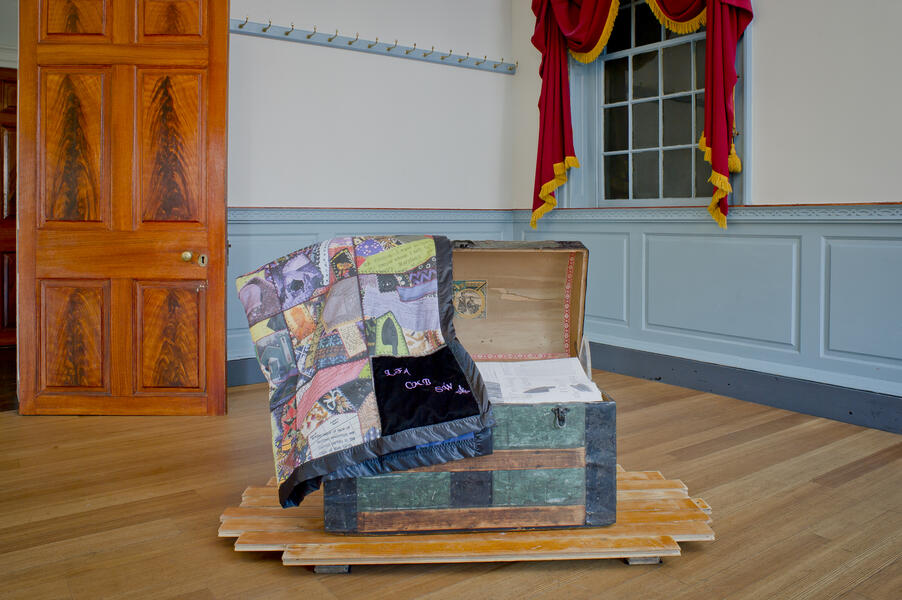 Centennial of the Everyday (collaborative project with Stewart Watson)Sculptural installation of the collaboration with Char McCargo Bah. From ‘A Particular Provenance’ in Gadsby’s Tavern Museum Ballroom. Char McCargo Bah, Stafford, Virginia Late 19th century traveling trunk Char is a professional genealogist, author, lecturer, civic activist, volunteer, Federal Government employee, mother, and native Alexandrian. Since 2008, as a consultant to the city, she has located dozens of descendants from those buried at the Contraband and Freedmen’s Cemetery, most of whom are five and six generations removed. The trunk is on loan from the artists as it reminds Char of one on display in the National Museum of African American History and Culture. Evidence of her many volumes of writing exploring her own family and genealogical research for others can be found in images on the quilt and in the trunk. Her favorite flora are the Japanese money tree, Christmas cactus, and African violet. Custom designed fabric, velvet, paper, indigo mudcloth, dyed fabric, embroidery, polyfil, paper The artists researched, identified, and invited 7 subjects to collaborate with in creating the sculptural installation of chairs in the Gadsby Tavern ballroom, with a special emphasis on working with women and people of color. Interviews were conducted in the spirit of identifying personal stories of place and family history, so as to connect the interviewees to broader themes of belonging, work, identity, and genealogy. Most interviewees live and work in Virginia, with the exception of two, who are descendants of John Gadsby now living in Philadelphia and New York (reflecting the connection to Gadsby’s stagecoach-era east coast travel lines). The presentation of chairs in the ballroom is a direct acknowledgement of the acquisition of the original 18th century woodwork by Thomas Fortune Ryan for The Metropolitan Museum in 1917 for installation in the Period Rooms of the American Wing. This centennial is celebrated in a display of altered furniture acquired from the interviewees, similar to how the Met Museum uses the ‘Alexandria Ballroom’ as a staged backdrop for the fine domestic furnishings of the Federal period. The artists’ reversal is a framework that points to the limitations of the museum space to ‘snap to life’. By actively including living, everyday people and their stories, the archival becomes interactive. Through interviews, multiple visits, and the connecting of these interviewees with Gadsby’s Museum, the artists render these individuals’ stories into fantastical and inventive sculptural objects that emphasize the extraordinary within the conventional, and the personal within the universal. ALL PHOTOS BY VINCE LUPO/DIRECTION ONE, INC.
Centennial of the Everyday (collaborative project with Stewart Watson)Sculptural installation of the collaboration with Char McCargo Bah. From ‘A Particular Provenance’ in Gadsby’s Tavern Museum Ballroom. Char McCargo Bah, Stafford, Virginia Late 19th century traveling trunk Char is a professional genealogist, author, lecturer, civic activist, volunteer, Federal Government employee, mother, and native Alexandrian. Since 2008, as a consultant to the city, she has located dozens of descendants from those buried at the Contraband and Freedmen’s Cemetery, most of whom are five and six generations removed. The trunk is on loan from the artists as it reminds Char of one on display in the National Museum of African American History and Culture. Evidence of her many volumes of writing exploring her own family and genealogical research for others can be found in images on the quilt and in the trunk. Her favorite flora are the Japanese money tree, Christmas cactus, and African violet. Custom designed fabric, velvet, paper, indigo mudcloth, dyed fabric, embroidery, polyfil, paper The artists researched, identified, and invited 7 subjects to collaborate with in creating the sculptural installation of chairs in the Gadsby Tavern ballroom, with a special emphasis on working with women and people of color. Interviews were conducted in the spirit of identifying personal stories of place and family history, so as to connect the interviewees to broader themes of belonging, work, identity, and genealogy. Most interviewees live and work in Virginia, with the exception of two, who are descendants of John Gadsby now living in Philadelphia and New York (reflecting the connection to Gadsby’s stagecoach-era east coast travel lines). The presentation of chairs in the ballroom is a direct acknowledgement of the acquisition of the original 18th century woodwork by Thomas Fortune Ryan for The Metropolitan Museum in 1917 for installation in the Period Rooms of the American Wing. This centennial is celebrated in a display of altered furniture acquired from the interviewees, similar to how the Met Museum uses the ‘Alexandria Ballroom’ as a staged backdrop for the fine domestic furnishings of the Federal period. The artists’ reversal is a framework that points to the limitations of the museum space to ‘snap to life’. By actively including living, everyday people and their stories, the archival becomes interactive. Through interviews, multiple visits, and the connecting of these interviewees with Gadsby’s Museum, the artists render these individuals’ stories into fantastical and inventive sculptural objects that emphasize the extraordinary within the conventional, and the personal within the universal. ALL PHOTOS BY VINCE LUPO/DIRECTION ONE, INC. -
 Centennial of the Everyday (collaborative project with Stewart Watson)Sculptural installation of the chair of DeAnne Bryant. From ‘A Particular Provenance’ in Gadsby’s Tavern Museum Ballroom. DeAnne Bryant, Alexandria, Virginia Early 21st century reproduction rocking chair, reproduction Masai spear, Central African woven basket, camel hair rug DeAnne is a State Department employee with former posts in Ethiopia, Kazakhstan, and South Africa. As a pedestrian commuter, you can find her walking to and from Alexandria, DC, and Mount Vernon for work and pleasure. With a love of travel and roots in the southwest, her family once owned an antique shop. She is connected to the American Legion (which saved these buildings), active in historic re-enactment, and Wreaths Across America. Her favorite flora are the big old trees in Alexandria, the color of Japanese maples in the fall, and the Jacaranda tree in South Africa. Revolutionary War musket ball, Civil War bullets, 19th century buttons & marbles, early Native American projectile point, Brown Bess musket reproduction on mylar, plexiglass, vinyl, tassels, clamp, thread The artists researched, identified, and invited 7 subjects to collaborate with in creating the sculptural installation of chairs in the Gadsby Tavern ballroom, with a special emphasis on working with women and people of color. Interviews were conducted in the spirit of identifying personal stories of place and family history, so as to connect the interviewees to broader themes of belonging, work, identity, and genealogy. Most interviewees live and work in Virginia, with the exception of two, who are descendants of John Gadsby now living in Philadelphia and New York (reflecting the connection to Gadsby’s stagecoach-era east coast travel lines). The presentation of chairs in the ballroom is a direct acknowledgement of the acquisition of the original 18th century woodwork by Thomas Fortune Ryan for The Metropolitan Museum in 1917 for installation in the Period Rooms of the American Wing. This centennial is celebrated in a display of altered furniture acquired from the interviewees, similar to how the Met Museum uses the ‘Alexandria Ballroom’ as a staged backdrop for the fine domestic furnishings of the Federal period. The artists’ reversal is a framework that points to the limitations of the museum space to ‘snap to life’. By actively including living, everyday people and their stories, the archival becomes interactive. Through interviews, multiple visits, and the connecting of these interviewees with Gadsby’s Museum, the artists render these individuals’ stories into fantastical and inventive sculptural objects that emphasize the extraordinary within the conventional, and the personal within the universal. ALL PHOTOS BY VINCE LUPO/DIRECTION ONE, INC.
Centennial of the Everyday (collaborative project with Stewart Watson)Sculptural installation of the chair of DeAnne Bryant. From ‘A Particular Provenance’ in Gadsby’s Tavern Museum Ballroom. DeAnne Bryant, Alexandria, Virginia Early 21st century reproduction rocking chair, reproduction Masai spear, Central African woven basket, camel hair rug DeAnne is a State Department employee with former posts in Ethiopia, Kazakhstan, and South Africa. As a pedestrian commuter, you can find her walking to and from Alexandria, DC, and Mount Vernon for work and pleasure. With a love of travel and roots in the southwest, her family once owned an antique shop. She is connected to the American Legion (which saved these buildings), active in historic re-enactment, and Wreaths Across America. Her favorite flora are the big old trees in Alexandria, the color of Japanese maples in the fall, and the Jacaranda tree in South Africa. Revolutionary War musket ball, Civil War bullets, 19th century buttons & marbles, early Native American projectile point, Brown Bess musket reproduction on mylar, plexiglass, vinyl, tassels, clamp, thread The artists researched, identified, and invited 7 subjects to collaborate with in creating the sculptural installation of chairs in the Gadsby Tavern ballroom, with a special emphasis on working with women and people of color. Interviews were conducted in the spirit of identifying personal stories of place and family history, so as to connect the interviewees to broader themes of belonging, work, identity, and genealogy. Most interviewees live and work in Virginia, with the exception of two, who are descendants of John Gadsby now living in Philadelphia and New York (reflecting the connection to Gadsby’s stagecoach-era east coast travel lines). The presentation of chairs in the ballroom is a direct acknowledgement of the acquisition of the original 18th century woodwork by Thomas Fortune Ryan for The Metropolitan Museum in 1917 for installation in the Period Rooms of the American Wing. This centennial is celebrated in a display of altered furniture acquired from the interviewees, similar to how the Met Museum uses the ‘Alexandria Ballroom’ as a staged backdrop for the fine domestic furnishings of the Federal period. The artists’ reversal is a framework that points to the limitations of the museum space to ‘snap to life’. By actively including living, everyday people and their stories, the archival becomes interactive. Through interviews, multiple visits, and the connecting of these interviewees with Gadsby’s Museum, the artists render these individuals’ stories into fantastical and inventive sculptural objects that emphasize the extraordinary within the conventional, and the personal within the universal. ALL PHOTOS BY VINCE LUPO/DIRECTION ONE, INC. -
 Centennial of the Everyday (collaborative project with Stewart Watson)Sculptural installation of the chair of Lex Powers. From ‘A Particular Provenance’ in Gadsby’s Tavern Museum Ballroom. Lex Powers, Philadelphia, Pennsylvania Mid 20th century Chippendale chair Lex is the 5x great grandson of Provey Norris and John Gadsby, but did not know this until the artists contacted him. He is a city planner who is committed to traffic calming and urban design that is pedestrian-forward. The sculpture resembles a bicycle and is outfitted with patterns representing the numerous buildings owned and occupied by John Gadsby, a nod to Lex’s professional commitment to urban design. His grandmother, to whom this chair belonged, used to encourage committing poems to memory. He can still remember and recite them. He is engaged to be married. His favorite flora is forsythia, which is a golden hue that complements his favorite color, blue. Custom designed fabrics, early 19th century silk with embroidery gifted by other Gadsby descendant, steel, bicycle rack, hardware, horn, antique compasses, maps, keys, wheel, vinyl, gimp ALL PHOTOS BY VINCE LUPO/DIRECTION ONE, INC.
Centennial of the Everyday (collaborative project with Stewart Watson)Sculptural installation of the chair of Lex Powers. From ‘A Particular Provenance’ in Gadsby’s Tavern Museum Ballroom. Lex Powers, Philadelphia, Pennsylvania Mid 20th century Chippendale chair Lex is the 5x great grandson of Provey Norris and John Gadsby, but did not know this until the artists contacted him. He is a city planner who is committed to traffic calming and urban design that is pedestrian-forward. The sculpture resembles a bicycle and is outfitted with patterns representing the numerous buildings owned and occupied by John Gadsby, a nod to Lex’s professional commitment to urban design. His grandmother, to whom this chair belonged, used to encourage committing poems to memory. He can still remember and recite them. He is engaged to be married. His favorite flora is forsythia, which is a golden hue that complements his favorite color, blue. Custom designed fabrics, early 19th century silk with embroidery gifted by other Gadsby descendant, steel, bicycle rack, hardware, horn, antique compasses, maps, keys, wheel, vinyl, gimp ALL PHOTOS BY VINCE LUPO/DIRECTION ONE, INC. -
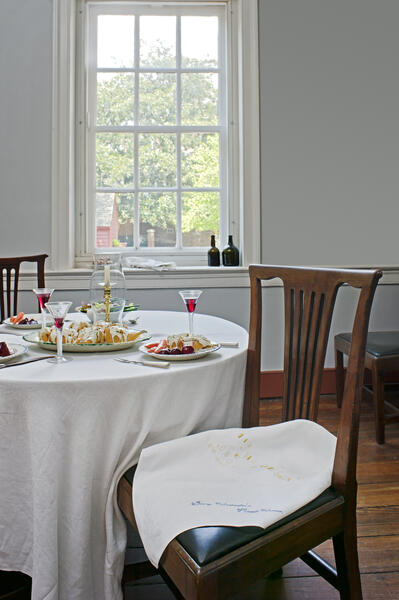 Centennial of the Everyday (collaborative project with Stewart Watson)Labor to keep alive in your breast that little spark of celestial fire called conscience Antique linen napkin with embroidery This napkin traces the recent archeological surveys of unmarked graves of the ‘negro burying ground’ at George Washington’s Mount Vernon. The artists visited the site and consulted with the Archeology Lab at Mount Vernon, learning about the burial practices of the peoples who were enslaved at Mount Vernon in the 18th and 19th centuries, as well as the layered histories of the site, from pre-historic Native American hunting ground to sacred 21st century meaning. The title is a reference to the 110th rule in a 110 Rules of Civility & Decent Behavior in Company and Conversation, which George Washington copied out by hand at age 16. ALL PHOTOS BY VINCE LUPO/DIRECTION ONE, INC.
Centennial of the Everyday (collaborative project with Stewart Watson)Labor to keep alive in your breast that little spark of celestial fire called conscience Antique linen napkin with embroidery This napkin traces the recent archeological surveys of unmarked graves of the ‘negro burying ground’ at George Washington’s Mount Vernon. The artists visited the site and consulted with the Archeology Lab at Mount Vernon, learning about the burial practices of the peoples who were enslaved at Mount Vernon in the 18th and 19th centuries, as well as the layered histories of the site, from pre-historic Native American hunting ground to sacred 21st century meaning. The title is a reference to the 110th rule in a 110 Rules of Civility & Decent Behavior in Company and Conversation, which George Washington copied out by hand at age 16. ALL PHOTOS BY VINCE LUPO/DIRECTION ONE, INC. -
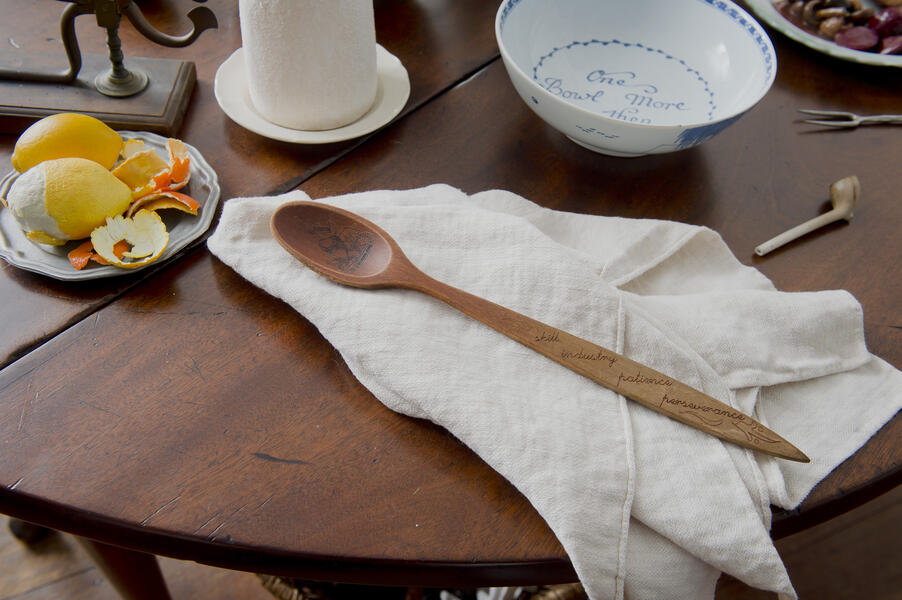 Centennial of the Everyday (collaborative project with Stewart Watson)The Abolitionist’s Hard Times Spoon Etched primitive wooden spoon with 19th century anti-slavery imagery. Abolitionist campaigns in England and America in the 18th and 19th centuries included the reproduction of such images on pottery, brooches, and hairpieces. The words reference Frederick Douglass’ essay, ‘Why I Became a Woman’s Rights Man,’ from his book Life and Times of Frederick Douglass, where he states: “Her skill, industry, patience, and perseverance have been wonderfully manifest in every trial hour.” ALL PHOTOS BY VINCE LUPO/DIRECTION ONE, INC.
Centennial of the Everyday (collaborative project with Stewart Watson)The Abolitionist’s Hard Times Spoon Etched primitive wooden spoon with 19th century anti-slavery imagery. Abolitionist campaigns in England and America in the 18th and 19th centuries included the reproduction of such images on pottery, brooches, and hairpieces. The words reference Frederick Douglass’ essay, ‘Why I Became a Woman’s Rights Man,’ from his book Life and Times of Frederick Douglass, where he states: “Her skill, industry, patience, and perseverance have been wonderfully manifest in every trial hour.” ALL PHOTOS BY VINCE LUPO/DIRECTION ONE, INC. -
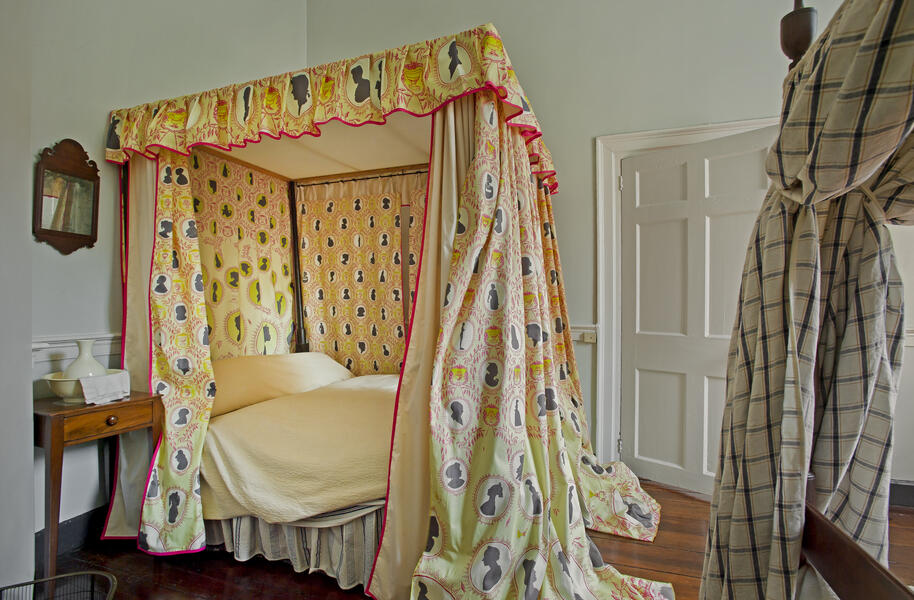 Centennial of the Everyday (collaborative project with Stewart Watson)Not on View Custom designed textile on historic canopy bed Fabrication assistance, seamstress Amber Whitehead The Female Stranger is a local legend passed down over 100 years. While the details change depending upon who you ask, it revolves around a gravely ill woman who arrived at this hotel in 1816 and passed away. The only evidence remaining is a tombstone in St. Paul’s Episcopal Church Cemetery “To the Memory of a Female Stranger.” In the spirit of the Female Stranger’s shifting biography, this textile pattern features silhouettes of anonymous women, many found within the Metropolitan Museum of Art’s collection: · Slave belonging to Mrs. Oyley · Peruvian woman · Young Girl of African Descent by Powell · Madame X by Sargent · Woman, left profile, by Walker Evans · Slave belonging to Mr. Dalman · Girl with Dog · Silhouette image of a Kabuki actor · Relief of a head of woman in ivory · Archaic Greek terracotta woman 5th c. BC · 19th c. German Ornament with Profile Portrait · Young Woman Praying by Henner · Profile of a woman with necrosis of the nose by Bisson · Woman in White by Picasso · From the Girls and Children series promoting Our Little Beauties Cigarettes for Allen & Ginter brand tobacco products The textile’s pattern is inspired by a historic George Washington centennial pattern from 1876 in the Met Museum’s collection. ALL PHOTOS BY VINCE LUPO/DIRECTION ONE, INC.
Centennial of the Everyday (collaborative project with Stewart Watson)Not on View Custom designed textile on historic canopy bed Fabrication assistance, seamstress Amber Whitehead The Female Stranger is a local legend passed down over 100 years. While the details change depending upon who you ask, it revolves around a gravely ill woman who arrived at this hotel in 1816 and passed away. The only evidence remaining is a tombstone in St. Paul’s Episcopal Church Cemetery “To the Memory of a Female Stranger.” In the spirit of the Female Stranger’s shifting biography, this textile pattern features silhouettes of anonymous women, many found within the Metropolitan Museum of Art’s collection: · Slave belonging to Mrs. Oyley · Peruvian woman · Young Girl of African Descent by Powell · Madame X by Sargent · Woman, left profile, by Walker Evans · Slave belonging to Mr. Dalman · Girl with Dog · Silhouette image of a Kabuki actor · Relief of a head of woman in ivory · Archaic Greek terracotta woman 5th c. BC · 19th c. German Ornament with Profile Portrait · Young Woman Praying by Henner · Profile of a woman with necrosis of the nose by Bisson · Woman in White by Picasso · From the Girls and Children series promoting Our Little Beauties Cigarettes for Allen & Ginter brand tobacco products The textile’s pattern is inspired by a historic George Washington centennial pattern from 1876 in the Met Museum’s collection. ALL PHOTOS BY VINCE LUPO/DIRECTION ONE, INC. -
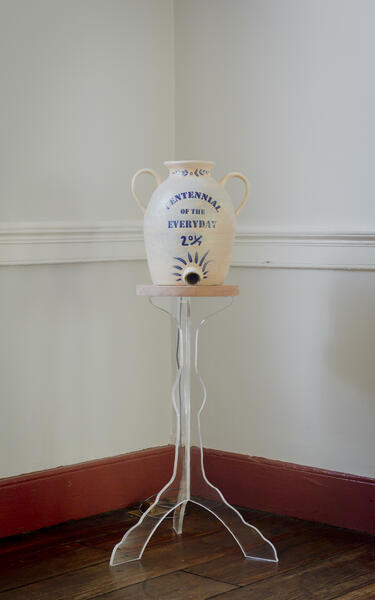 Centennial of the Everyday (collaborative project with Stewart Watson)Installation view of the soda fired stoneware in the Assembly Room at Gadsby’s Tavern Museum. Vestige Vessels: Centennial of the Everyday Soda fired stoneware, looping video, plexiglass, walnut Stoneware made in collaboration with Jani Hileman and Mat Karas at the Maryland Institute College of Art Ceramics Department, Baltimore Videos produced in collaboration with Jonathan Monaghan In the Centennial of the Everyday vessel, an 18th century coconut sherd from the Alexandria Archaeology collection is shown as a spinning animation. This sherd represents the wide variety of goods and people brought to Alexandria’s shores as an active port city. Project collaborators Char McCargo Bah and Stephen Hammond read 3 poems that they chose: “The Negro Speaks of Rivers” (by Langston Hughes), “That Man is a Success” (by Robert Louis Stevenson), and “Caged Bird” (by Maya Angelou). ALL PHOTOS VINCE LUPO/DIRECTION ONE, INC.
Centennial of the Everyday (collaborative project with Stewart Watson)Installation view of the soda fired stoneware in the Assembly Room at Gadsby’s Tavern Museum. Vestige Vessels: Centennial of the Everyday Soda fired stoneware, looping video, plexiglass, walnut Stoneware made in collaboration with Jani Hileman and Mat Karas at the Maryland Institute College of Art Ceramics Department, Baltimore Videos produced in collaboration with Jonathan Monaghan In the Centennial of the Everyday vessel, an 18th century coconut sherd from the Alexandria Archaeology collection is shown as a spinning animation. This sherd represents the wide variety of goods and people brought to Alexandria’s shores as an active port city. Project collaborators Char McCargo Bah and Stephen Hammond read 3 poems that they chose: “The Negro Speaks of Rivers” (by Langston Hughes), “That Man is a Success” (by Robert Louis Stevenson), and “Caged Bird” (by Maya Angelou). ALL PHOTOS VINCE LUPO/DIRECTION ONE, INC.
Precarious Prototypes
As installed at the Walters Museum, with textiles of the artist's design as well as museum objects.
-
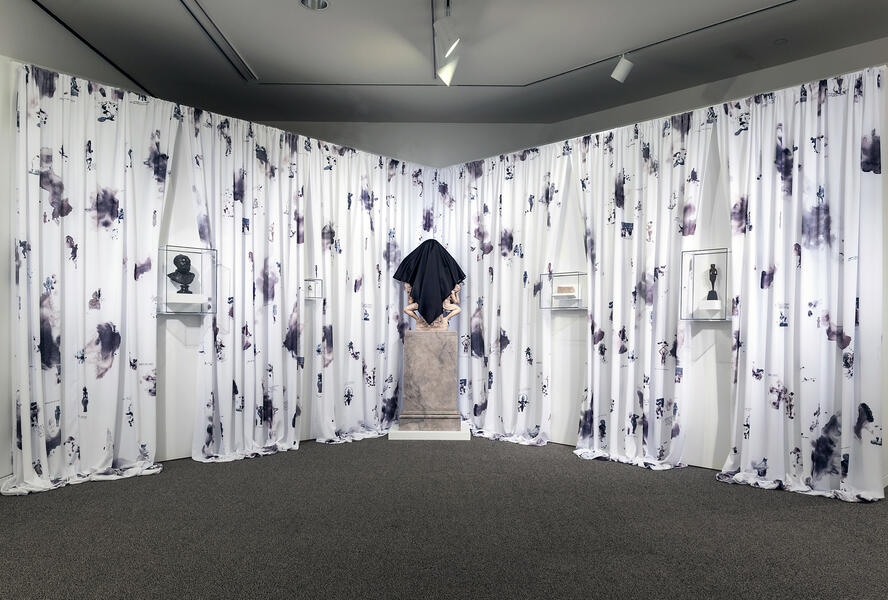 Precarious PrototypesPrecarious Prototypes, a textile installation that responds to and transforms selected objects from the Walters Art Museum’s collection.
Precarious PrototypesPrecarious Prototypes, a textile installation that responds to and transforms selected objects from the Walters Art Museum’s collection. -
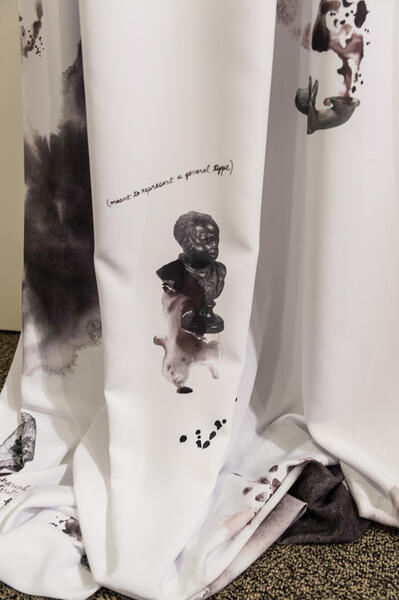 Precarious PrototypesPrecarious Prototypes, a textile installation that responds to and transforms selected objects from the Walters Art Museum’s collection.
Precarious PrototypesPrecarious Prototypes, a textile installation that responds to and transforms selected objects from the Walters Art Museum’s collection. -
 Precarious PrototypesPrecarious Prototypes, a textile installation that responds to and transforms selected objects from the Walters Art Museum’s collection.
Precarious PrototypesPrecarious Prototypes, a textile installation that responds to and transforms selected objects from the Walters Art Museum’s collection. -
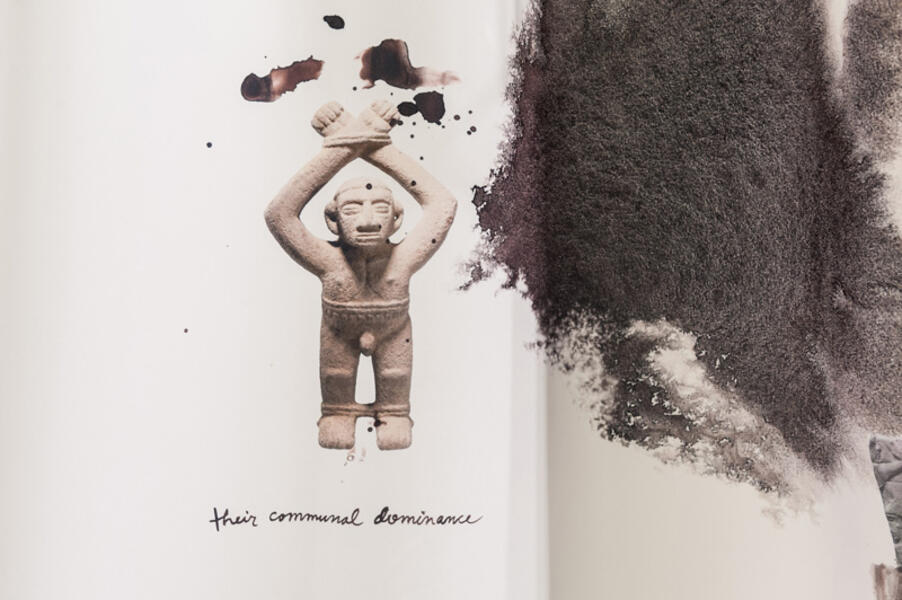 Precarious PrototypesPrecarious Prototypes, a textile installation that responds to and transforms selected objects from the Walters Art Museum’s collection.
Precarious PrototypesPrecarious Prototypes, a textile installation that responds to and transforms selected objects from the Walters Art Museum’s collection. -
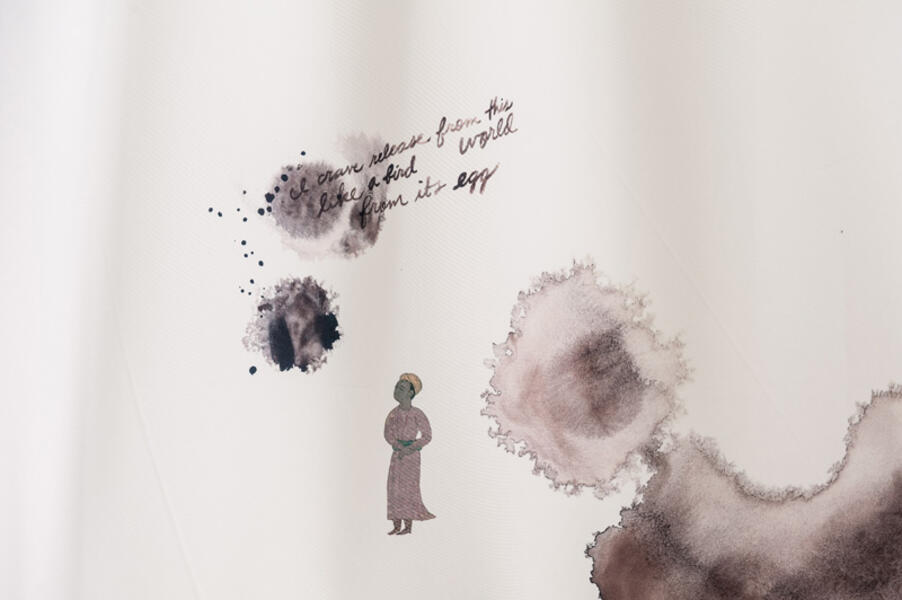 la-2014-08-11-044.jpgPrecarious Prototypes, a textile installation that responds to and transforms selected objects from the Walters Art Museum’s collection.
la-2014-08-11-044.jpgPrecarious Prototypes, a textile installation that responds to and transforms selected objects from the Walters Art Museum’s collection. -
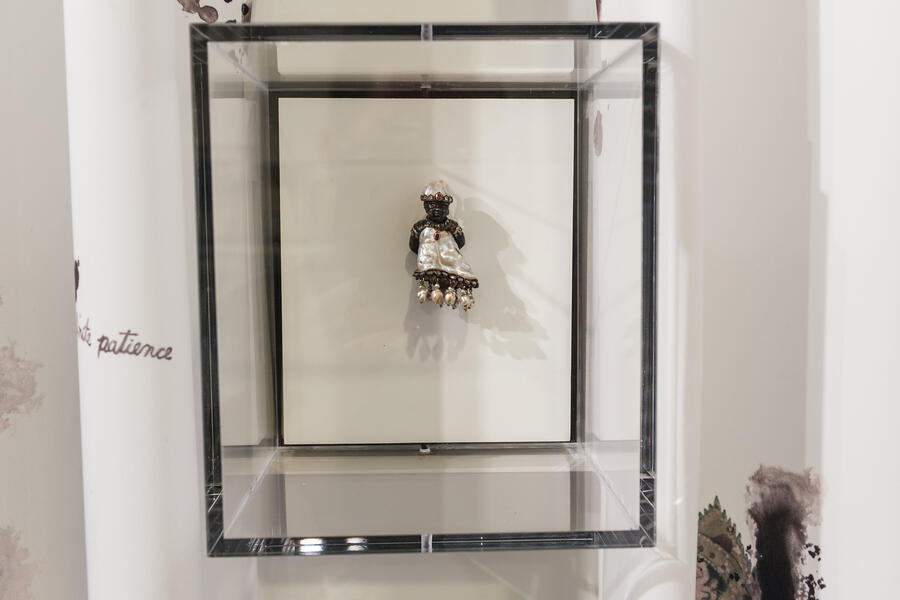 Precarious PrototypesPrecarious Prototypes, a textile installation that responds to and transforms selected objects from the Walters Art Museum’s collection.
Precarious PrototypesPrecarious Prototypes, a textile installation that responds to and transforms selected objects from the Walters Art Museum’s collection. -
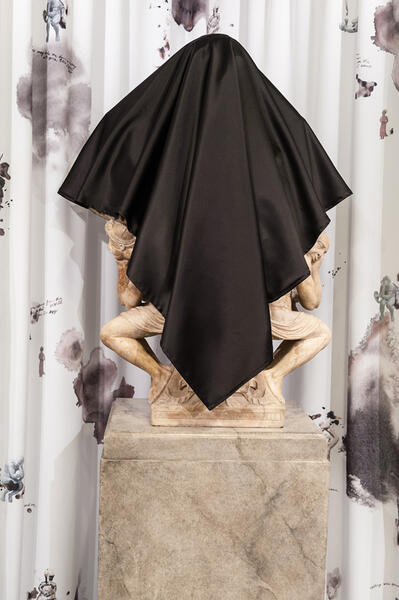 Precarious PrototypesPrecarious Prototypes, a textile installation that responds to and transforms selected objects from the Walters Art Museum’s collection.
Precarious PrototypesPrecarious Prototypes, a textile installation that responds to and transforms selected objects from the Walters Art Museum’s collection. -
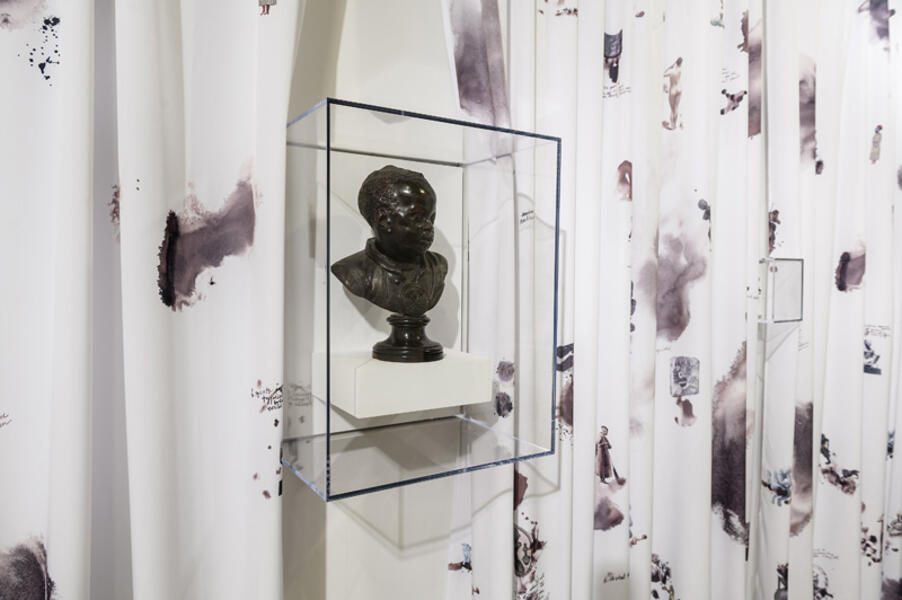 Precarious PrototypesPrecarious Prototypes, a textile installation that responds to and transforms selected objects from the Walters Art Museum’s collection.
Precarious PrototypesPrecarious Prototypes, a textile installation that responds to and transforms selected objects from the Walters Art Museum’s collection. -
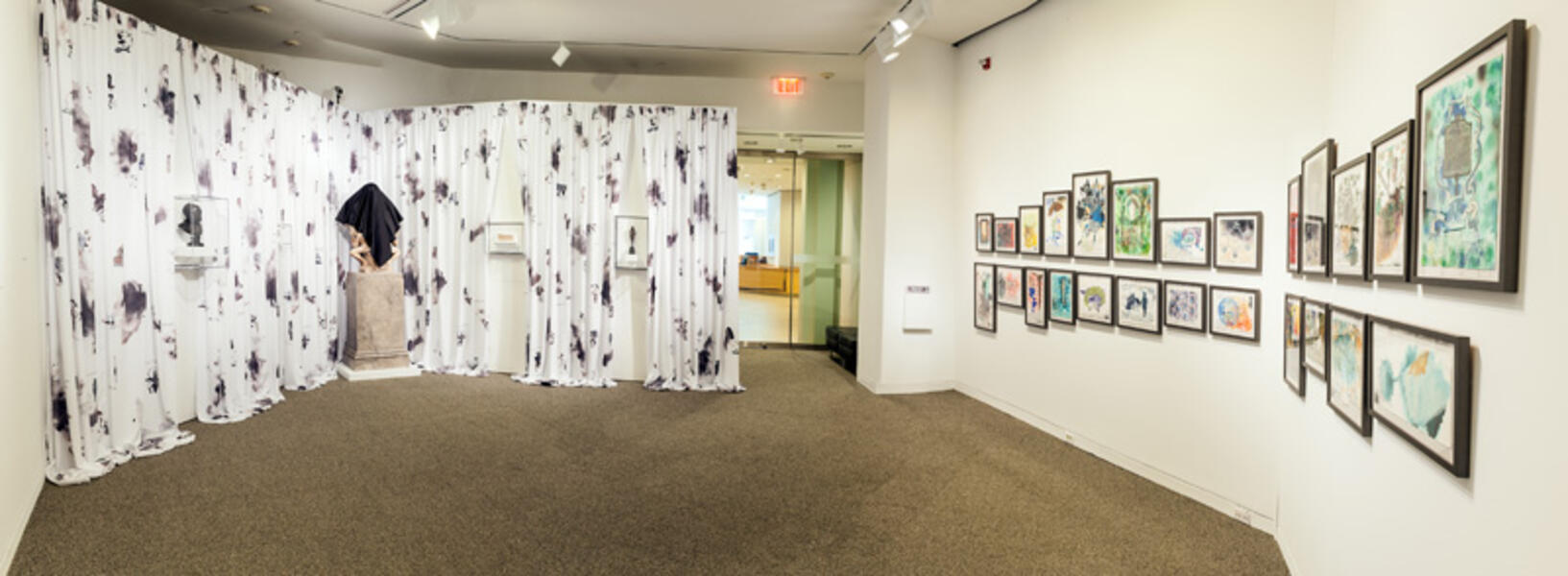 Precarious PrototypesPrecarious Prototypes, a textile installation that responds to and transforms selected objects from the Walters Art Museum’s collection. shown also with Decorum, as installed at the Walters Art Museum
Precarious PrototypesPrecarious Prototypes, a textile installation that responds to and transforms selected objects from the Walters Art Museum’s collection. shown also with Decorum, as installed at the Walters Art Museum -
 Precarious PrototypesDecorum, as installed at the Walters Art Museum, 2014
Precarious PrototypesDecorum, as installed at the Walters Art Museum, 2014
American Catastrophe Report
Washington, D.C.
Artist Lauren Frances Adams has created American Catastrophe Report, an installation that acts as both homage and critique of the decorative frescoes in the United States Capitol Building, originally painted in the 19th c. by Italian-born artist Constantino Brumidi. The site-specific artwork by Adams is installed in American University’s Katzen Arts Center, in both the upper and lower rotunda in the center of the building, less than six miles from where Brumidi’s paintings are located. The prints forming American Catastrophe Report have the appearance of paintings due to the unique process Adams uses, where hand-painted originals are digitally scanned then printed for long-term public display. Adams updates Brumidi’s Capitol ornamentation by directly addressing ecological disasters in America that have been caused by human activities.
Visitors to the Katzen Arts Center will see an installation that is a mix of appropriated and invented imagery. Adams adapts Brumidi’s original frescoes in the U.S. Senate Wing that picture landscapes of the sparsely populated western states of the mid-19th century, as well as a variety of detailed images of birds. According to historians, Brumidi copied from lithographs in the Pacific Railroad Report and the Mexican Boundary Report, published in the 1850’s. It is possible that Brumidi’s incorporation of these landscapes were intended to not only celebrate scenic visions of America but also to promote a comprehensive identity of American geography and inevitable settlement. Further promoting specificity of place, the birds pictured in the Senate wing point to the importance of uniquely American subject matter in Brumidi’s efforts. Assistant curator for the Office of Senate Curator, Amy Elizabeth Burton, writes about the time capsule nature of the paintings, stating in the catalogue (published in 2014) To Make Beautiful the Capitol: Rediscovering the Art of Constantino Brumidi, “Brumidi’s birds reflect the 19-century surge in westward expansion and federal support for exploration and scientific discovery across the young and developing nation.”
Extending and celebrating this act of copying, Lauren Frances Adams has updated Brumidi’s masterful efforts with similar themes -- landscapes and ornithological images -- but with a decidedly different artistic outcome. Reflecting a century and a half of human enterprise since Brumidi’s time, a selection of landscapes in decorative cartouches offers up these situations: Fracking (in rural Pennsylvania), the Great Pacific Garbage Patch, Mountaintop Removal Mining (in West Virginia), the Deepwater Horizon Oil Spill (in the Gulf of Mexico), and Climate Change (specified as glacial retreat in Alaska). Corresponding to each man-made ecological disaster, and pointing towards the totalizing effects of habitat destruction, pollution via chemicals and garbage, and changes in weather conditions, Adams has included several birds that represent the threats to fauna as environmental destruction advances: Scarlet Tanager, Bristle-Thighed Curlew, Cerulean Warbler, Brown Pelican, and the Tufted Puffin.
Other imagery present throughout the rotunda gives depth to the historical relationships between American citizens and our physical landscape. Acting as symbolic prescience, ornamental designs incorporate two birds distinctly absent from America today: the Carolina Parakeet and the Passenger Pigeon, both extinct. Decorative flora in the paintings incorporates kudzu, a non-native species that has caused widespread ecological damage in the United States. Other imagery near the project signage incorporates invasive species in North America: Africanized bee, Common Starling, Nutria, Cabbage White butterfly, and the Emerald Ash Borer. Lofted high above, two medallions face one another in the upper rotunda: a war-like eagle and a gentle lamb. Utilizing the neoclassical aesthetic employed by Constantino Brumidi (who was in turn inspired by ornamental Renaissance paintings in the Vatican), Adams incorporates uniquely American identifications, inviting visitors to the American University Katzen Arts Center to reflect upon the conundrum of the contemporary American condition visualized in American Catastrophe Report.
-
 American Catastrophe Reportoverall installation at Katzen Arts Center through May 2015
American Catastrophe Reportoverall installation at Katzen Arts Center through May 2015 -
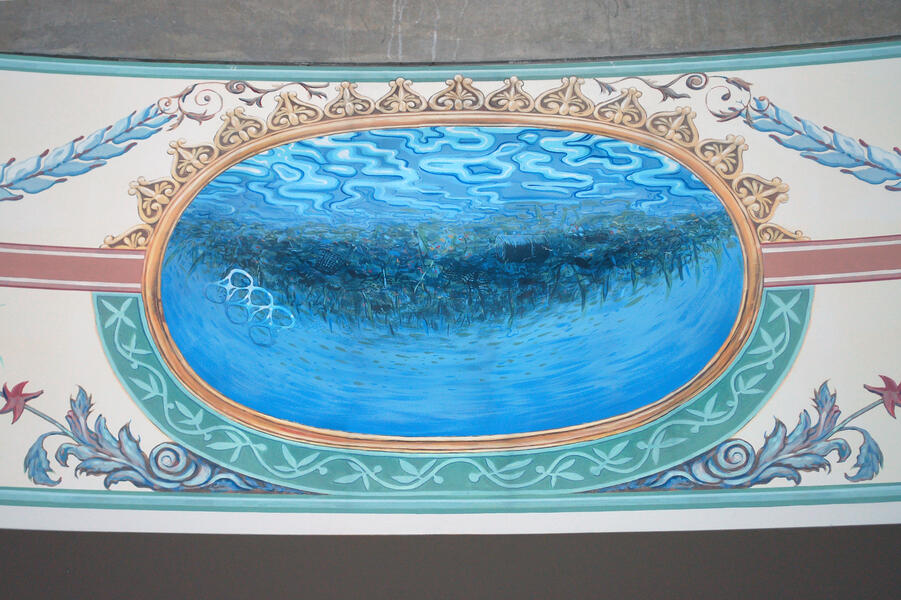 American Catastrophe Reportoverall installation at Katzen Arts Center through May 2015 showing Great Pacific Garbage Patch cartouche
American Catastrophe Reportoverall installation at Katzen Arts Center through May 2015 showing Great Pacific Garbage Patch cartouche -
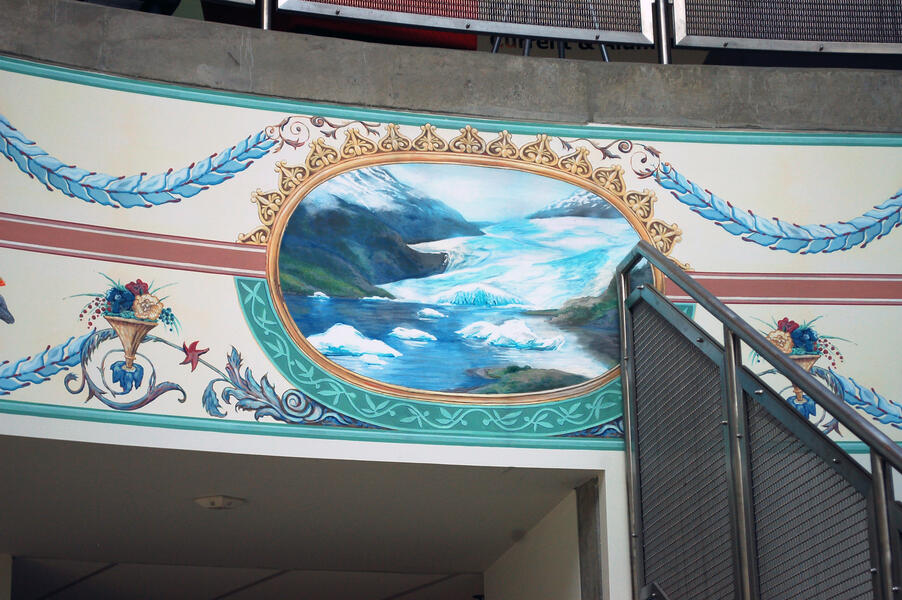 American Catastrophe Reportoverall installation at Katzen Arts Center through May 2015 showing Glacial Retreat in Alaska cartouche
American Catastrophe Reportoverall installation at Katzen Arts Center through May 2015 showing Glacial Retreat in Alaska cartouche -
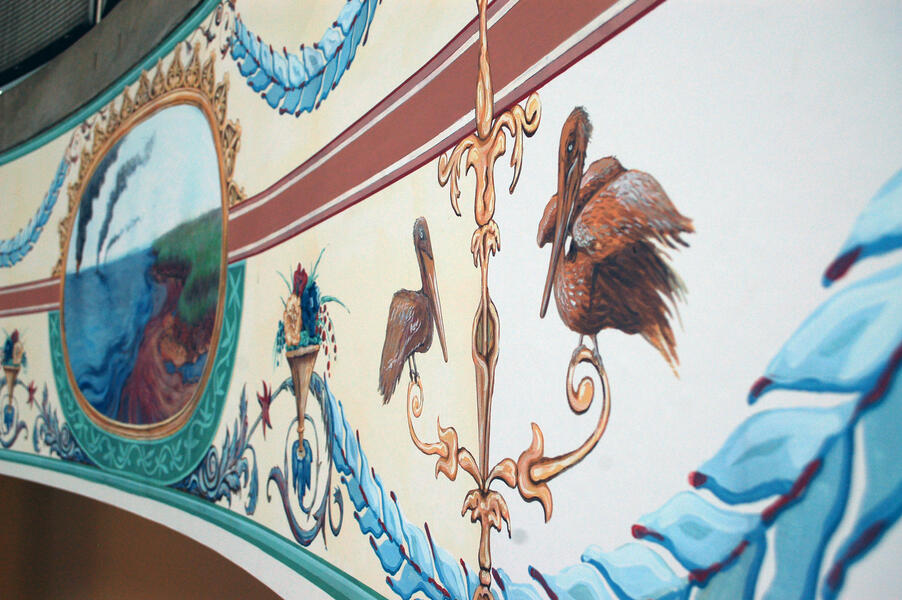 American Catastrophe Reportoverall installation at Katzen Arts Center through May 2015 showing Deepwater Horizon Oil Spill cartouche with oil-covered birds
American Catastrophe Reportoverall installation at Katzen Arts Center through May 2015 showing Deepwater Horizon Oil Spill cartouche with oil-covered birds -
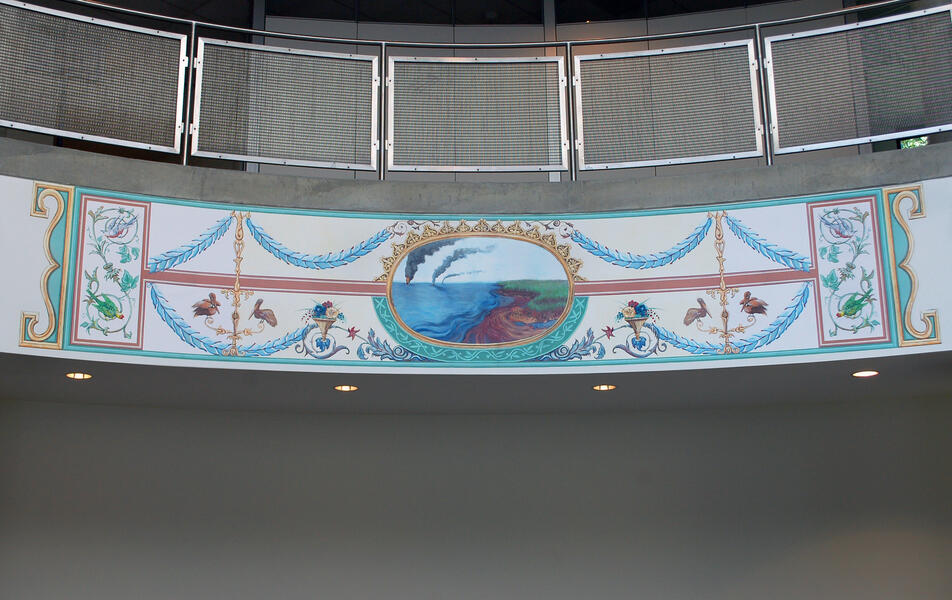 American Catastrophe ReportAmerican Catastrophe Report installation at Katzen Arts Center through 2014 - 2015 showing Deepwater Horizon Oil Spill cartouche with oil-covered birds
American Catastrophe ReportAmerican Catastrophe Report installation at Katzen Arts Center through 2014 - 2015 showing Deepwater Horizon Oil Spill cartouche with oil-covered birds -
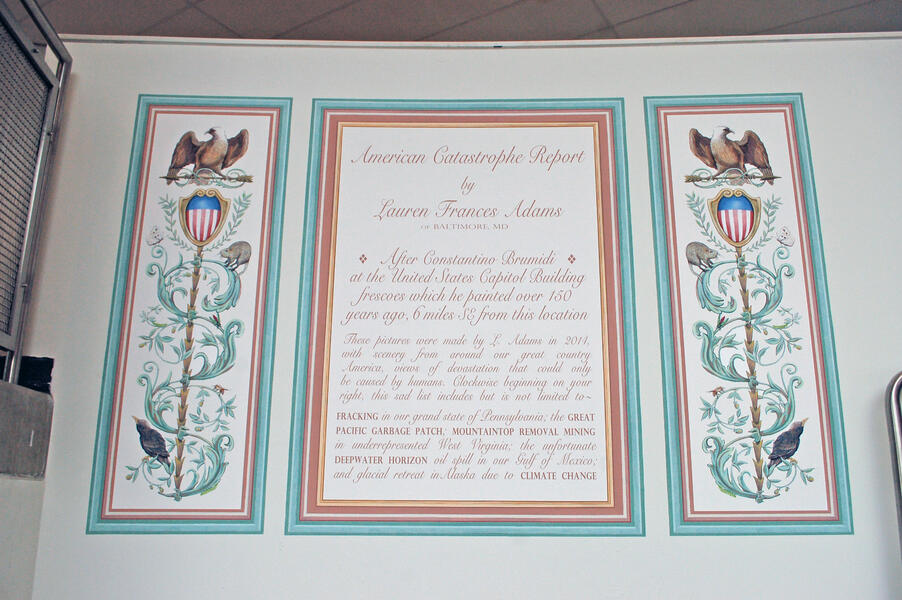 American Catastrophe Reportoverall view of signage for installation at Katzen Arts Center through May 2015 Signage details the sites shown in the 5 panels/cartouches as well as each bird included corresponding with the physical sites. Side panels show invasive species of North America.
American Catastrophe Reportoverall view of signage for installation at Katzen Arts Center through May 2015 Signage details the sites shown in the 5 panels/cartouches as well as each bird included corresponding with the physical sites. Side panels show invasive species of North America. -
 American Catastrophe Reportoverall view of installation at Katzen Arts Center through May 2015
American Catastrophe Reportoverall view of installation at Katzen Arts Center through May 2015 -
 American Catastrophe Reportdetail of Carolina Parakeets (extinct species) in the installation at Katzen Arts Center through May 2015
American Catastrophe Reportdetail of Carolina Parakeets (extinct species) in the installation at Katzen Arts Center through May 2015 -
 American Catastrophe Reportoverall installation at Katzen Arts Center through May 2015
American Catastrophe Reportoverall installation at Katzen Arts Center through May 2015 -
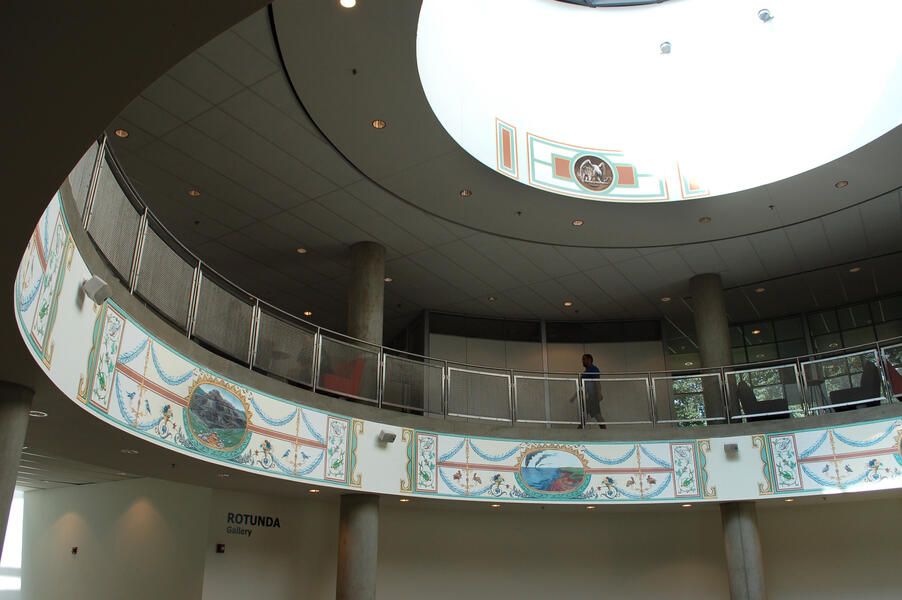 American Catastrophe Reportoverall installation at Katzen Arts Center through May 2015
American Catastrophe Reportoverall installation at Katzen Arts Center through May 2015
Grand Tour Fan
-
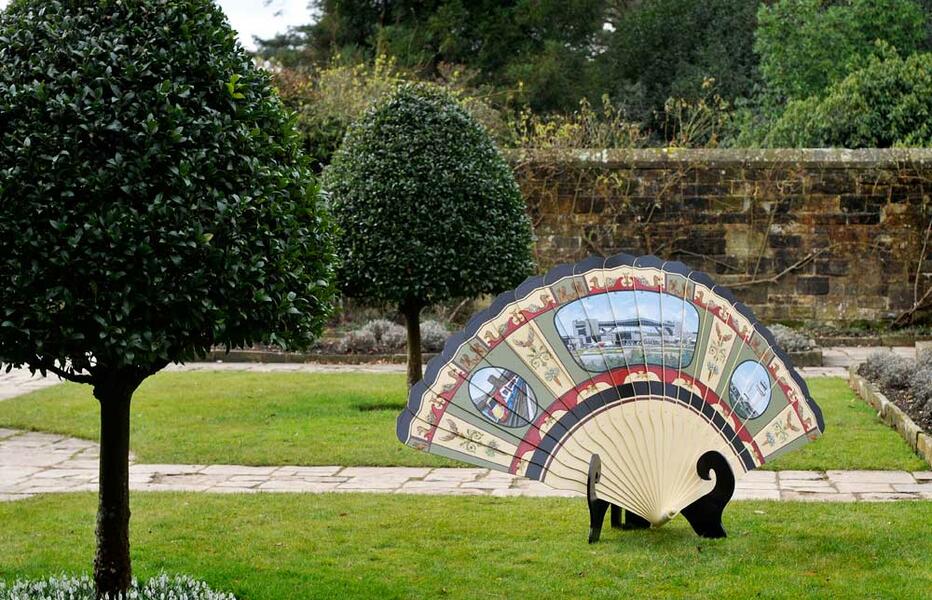 Grand Tour FanInstalled at Nymans House and Gardens in West Sussex, England for the exhibition Unravelling the National Trust. Nymans House and Garden is a National Trust property known primarily for its exquisite English garden, which has been designed and developed by three generations of the Messel family. The artwork is a large-scale fan inspired by the Messel family fan collection (at the Fitzwilliam Museum, Cambridge, UK). Grand Tour Fan appropriates from the original c. 18th century Grand Tour Fan on display in Cambridge. This fan inserts intentionally banal public places from contemporary Sussex life into the historical framework -- substituting scenes of Italian ruins with those of Gatwick Airport (just a few miles from Nymans House).
Grand Tour FanInstalled at Nymans House and Gardens in West Sussex, England for the exhibition Unravelling the National Trust. Nymans House and Garden is a National Trust property known primarily for its exquisite English garden, which has been designed and developed by three generations of the Messel family. The artwork is a large-scale fan inspired by the Messel family fan collection (at the Fitzwilliam Museum, Cambridge, UK). Grand Tour Fan appropriates from the original c. 18th century Grand Tour Fan on display in Cambridge. This fan inserts intentionally banal public places from contemporary Sussex life into the historical framework -- substituting scenes of Italian ruins with those of Gatwick Airport (just a few miles from Nymans House). -
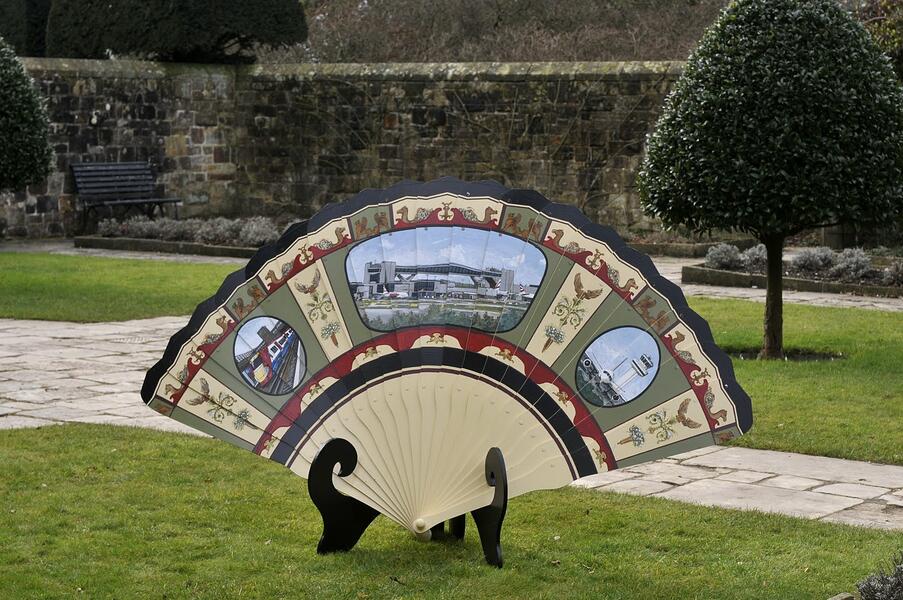 Grand Tour FanInstalled at Nymans House and Gardens in West Sussex, England for the exhibition Unravelling the National Trust. Nymans House and Garden is a National Trust property known primarily for its exquisite English garden, which has been designed and developed by three generations of the Messel family. The artwork is a large-scale fan inspired by the Messel family fan collection (at the Fitzwilliam Museum, Cambridge, UK). Grand Tour Fan appropriates from the original c. 18th century Grand Tour Fan on display in Cambridge. This fan inserts intentionally banal public places from contemporary Sussex life into the historical framework -- substituting scenes of Italian ruins with those of Gatwick Airport (just a few miles from Nymans House).
Grand Tour FanInstalled at Nymans House and Gardens in West Sussex, England for the exhibition Unravelling the National Trust. Nymans House and Garden is a National Trust property known primarily for its exquisite English garden, which has been designed and developed by three generations of the Messel family. The artwork is a large-scale fan inspired by the Messel family fan collection (at the Fitzwilliam Museum, Cambridge, UK). Grand Tour Fan appropriates from the original c. 18th century Grand Tour Fan on display in Cambridge. This fan inserts intentionally banal public places from contemporary Sussex life into the historical framework -- substituting scenes of Italian ruins with those of Gatwick Airport (just a few miles from Nymans House). -
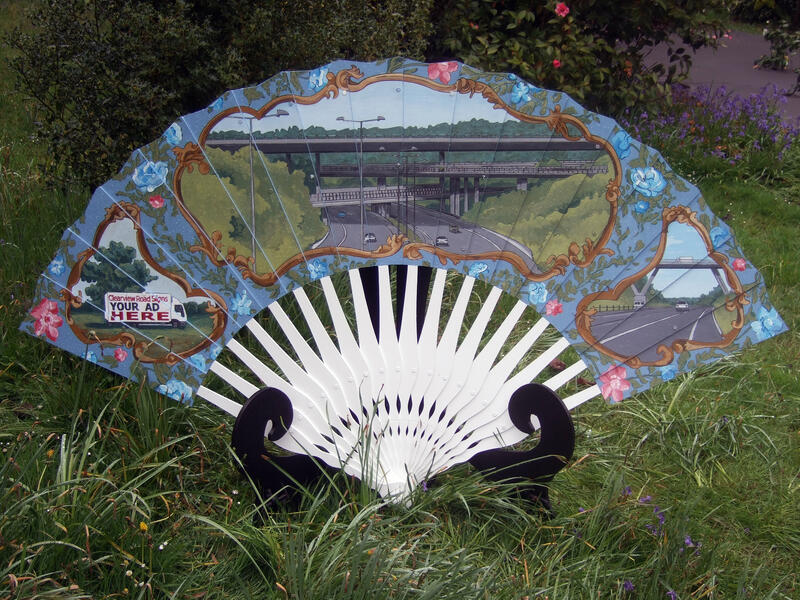 dscf0182b.jpgSecond fan on display in the Nymans House and Gardens. Road to Nymans pictures the M23 roadway, the main thoroughfare between London and Nymans, which elevates with absurd revisions of the ornamental fan scenes, challenging site-specific concepts of fantasy and utopia.
dscf0182b.jpgSecond fan on display in the Nymans House and Gardens. Road to Nymans pictures the M23 roadway, the main thoroughfare between London and Nymans, which elevates with absurd revisions of the ornamental fan scenes, challenging site-specific concepts of fantasy and utopia. -
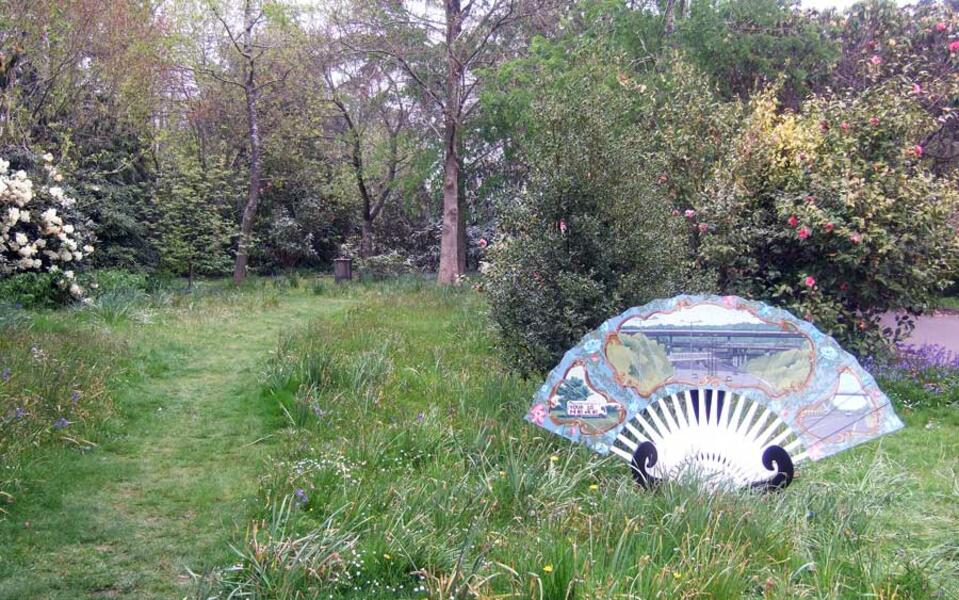 dscf0119a-900pxweb.jpgSecond fan on display in the Nymans House and Gardens. Road to Nymans pictures the M23 roadway, the main thoroughfare between London and Nymans, which elevates with absurd revisions of the ornamental fan scenes, challenging site-specific concepts of fantasy and utopia.
dscf0119a-900pxweb.jpgSecond fan on display in the Nymans House and Gardens. Road to Nymans pictures the M23 roadway, the main thoroughfare between London and Nymans, which elevates with absurd revisions of the ornamental fan scenes, challenging site-specific concepts of fantasy and utopia. -
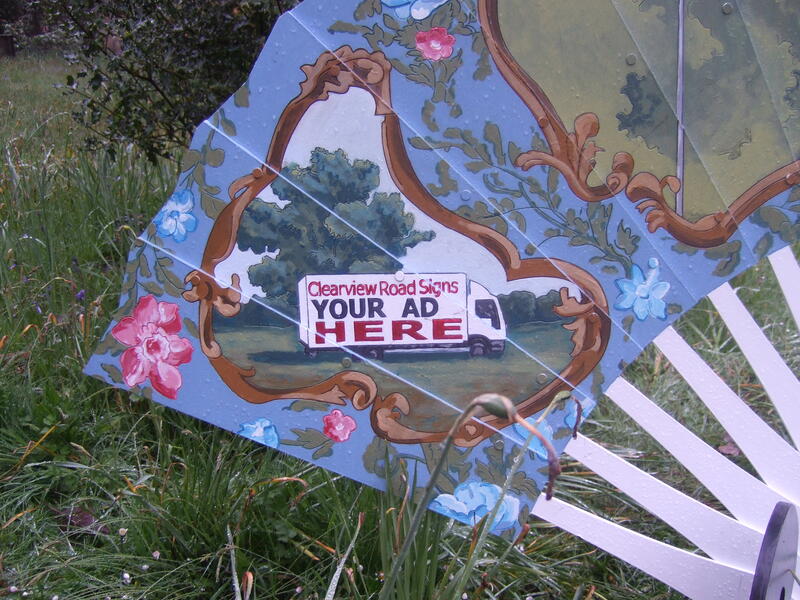 Road to Nymans FanSecond fan on display in the Nymans House and Gardens. Road to Nymans pictures the M23 roadway, the main thoroughfare between London and Nymans, which elevates with absurd revisions of the ornamental fan scenes, challenging site-specific concepts of fantasy and utopia.
Road to Nymans FanSecond fan on display in the Nymans House and Gardens. Road to Nymans pictures the M23 roadway, the main thoroughfare between London and Nymans, which elevates with absurd revisions of the ornamental fan scenes, challenging site-specific concepts of fantasy and utopia. -
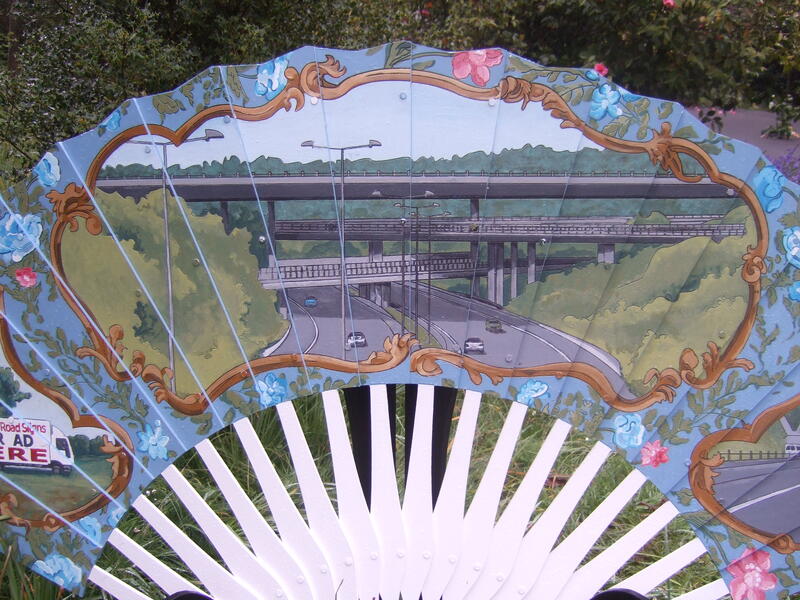 Road to NymansSecond fan on display in the Nymans House and Gardens. Road to Nymans pictures the M23 roadway, the main thoroughfare between London and Nymans, which elevates with absurd revisions of the ornamental fan scenes, challenging site-specific concepts of fantasy and utopia.
Road to NymansSecond fan on display in the Nymans House and Gardens. Road to Nymans pictures the M23 roadway, the main thoroughfare between London and Nymans, which elevates with absurd revisions of the ornamental fan scenes, challenging site-specific concepts of fantasy and utopia. -
 dscf0236a.jpg
dscf0236a.jpg -
 New Town Mock Tudor Fan
New Town Mock Tudor Fan -
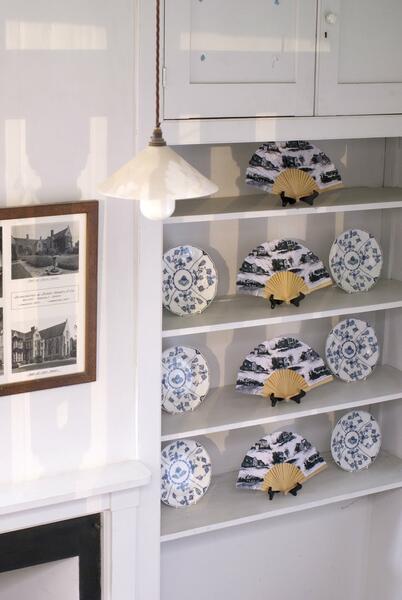 New Town Mock Tudor Fans
New Town Mock Tudor Fans
We the People
Lauren Adams: We the People is organized by the Contemporary Art Museum St. Louis (CAM) and curated by Kelly Shindler, Assistant Curator.
Lauren Adams’s work addresses historical issues of colonialism—the system by which the people of one territory establish systems of authority or control over people in another territory—and industrialization to demonstrate how they inform our present-day reality. Working in a variety of media from painting and drawing to textiles and printmaking, she repurposes centuries-old imagery to explore the relationship between labor and the production of material goods. Adams uses specific images, symbols, and situations from these histories to suggest how they play a significant role in the balance of power between social classes, nations, and ethnicities today.
We the People is an interactive installation in which the artist has painted slogans from recent Occupy Wall Street and Tea Party protests into reproduced Revolutionary War-era wallpaper. The pattern, entitled “General Samuel McClellan,” features a repeated image of various everyday objects from the 18th-century. Extracted and abstracted from its original context, the protest language visible on the wallpaper functions as a generalized call to action. Visitors to CAM’s booth can record their own “protest” on a unique ceramic plate to be displayed during the fair. A custom-designed tea towel made exclusively for Expo Chicago both advertises the project and is exchanged with visitors in return for their contributions.
-
 We the PeopleWe the People 2012 EXPO Chicago at the Navy Pier A solo booth presentation with the Contemporary Art Museum St. Louis We the People is an interactive installation in which the artist has painted slogans from recent Occupy Wall Street and Tea Party protests into reproduced Revolutionary War-era wallpaper. Visitors to the booth can record their own “protest” on a unique ceramic plate to be displayed during the fair. A custom-designed tea towel made exclusively for Expo Chicago both advertises the project and is exchanged with visitors in return for their contributions.
We the PeopleWe the People 2012 EXPO Chicago at the Navy Pier A solo booth presentation with the Contemporary Art Museum St. Louis We the People is an interactive installation in which the artist has painted slogans from recent Occupy Wall Street and Tea Party protests into reproduced Revolutionary War-era wallpaper. Visitors to the booth can record their own “protest” on a unique ceramic plate to be displayed during the fair. A custom-designed tea towel made exclusively for Expo Chicago both advertises the project and is exchanged with visitors in return for their contributions. -
 We the PeopleWe the People 2012 EXPO Chicago at the Navy Pier A solo booth presentation with the Contemporary Art Museum St. Louis We the People is an interactive installation in which the artist has painted slogans from recent Occupy Wall Street and Tea Party protests into reproduced Revolutionary War-era wallpaper. Visitors to the booth can record their own “protest” on a unique ceramic plate to be displayed during the fair. A custom-designed tea towel made exclusively for Expo Chicago both advertises the project and is exchanged with visitors in return for their contributions.
We the PeopleWe the People 2012 EXPO Chicago at the Navy Pier A solo booth presentation with the Contemporary Art Museum St. Louis We the People is an interactive installation in which the artist has painted slogans from recent Occupy Wall Street and Tea Party protests into reproduced Revolutionary War-era wallpaper. Visitors to the booth can record their own “protest” on a unique ceramic plate to be displayed during the fair. A custom-designed tea towel made exclusively for Expo Chicago both advertises the project and is exchanged with visitors in return for their contributions. -
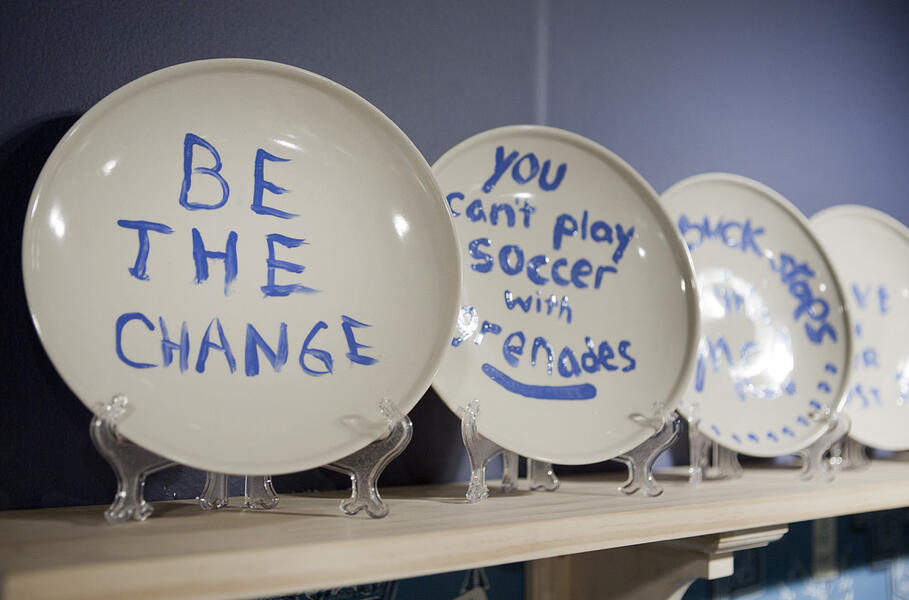 We the PeopleWe the People 2012 EXPO Chicago at the Navy Pier A solo booth presentation with the Contemporary Art Museum St. Louis We the People is an interactive installation in which the artist has painted slogans from recent Occupy Wall Street and Tea Party protests into reproduced Revolutionary War-era wallpaper. Visitors to the booth can record their own “protest” on a unique ceramic plate to be displayed during the fair. A custom-designed tea towel made exclusively for Expo Chicago both advertises the project and is exchanged with visitors in return for their contributions.
We the PeopleWe the People 2012 EXPO Chicago at the Navy Pier A solo booth presentation with the Contemporary Art Museum St. Louis We the People is an interactive installation in which the artist has painted slogans from recent Occupy Wall Street and Tea Party protests into reproduced Revolutionary War-era wallpaper. Visitors to the booth can record their own “protest” on a unique ceramic plate to be displayed during the fair. A custom-designed tea towel made exclusively for Expo Chicago both advertises the project and is exchanged with visitors in return for their contributions. -
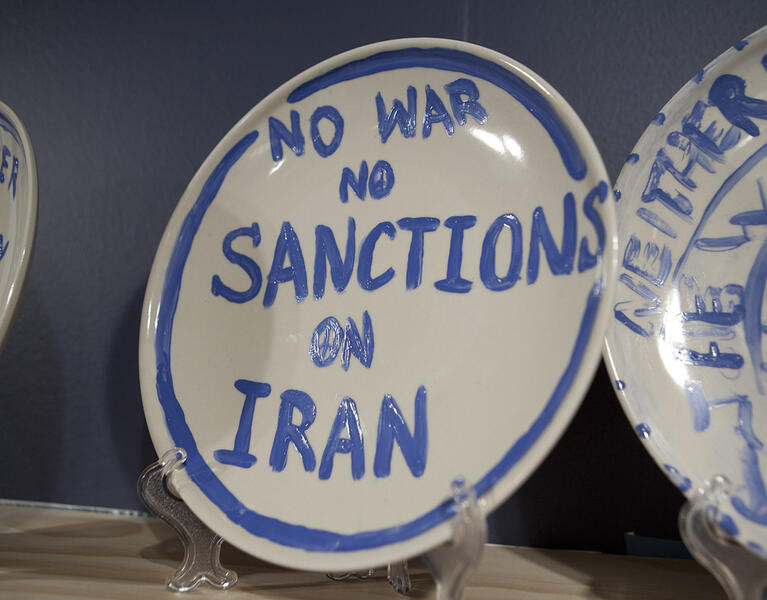 We the PeopleWe the People 2012 EXPO Chicago at the Navy Pier A solo booth presentation with the Contemporary Art Museum St. Louis We the People is an interactive installation in which the artist has painted slogans from recent Occupy Wall Street and Tea Party protests into reproduced Revolutionary War-era wallpaper. Visitors to the booth can record their own “protest” on a unique ceramic plate to be displayed during the fair. A custom-designed tea towel made exclusively for Expo Chicago both advertises the project and is exchanged with visitors in return for their contributions.
We the PeopleWe the People 2012 EXPO Chicago at the Navy Pier A solo booth presentation with the Contemporary Art Museum St. Louis We the People is an interactive installation in which the artist has painted slogans from recent Occupy Wall Street and Tea Party protests into reproduced Revolutionary War-era wallpaper. Visitors to the booth can record their own “protest” on a unique ceramic plate to be displayed during the fair. A custom-designed tea towel made exclusively for Expo Chicago both advertises the project and is exchanged with visitors in return for their contributions. -
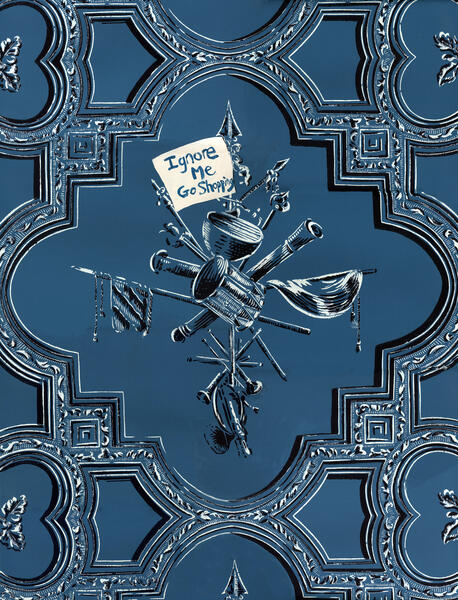 We the PeopleWe the People 2012 EXPO Chicago at the Navy Pier A solo booth presentation with the Contemporary Art Museum St. Louis We the People is an interactive installation in which the artist has painted slogans from recent Occupy Wall Street and Tea Party protests into reproduced Revolutionary War-era wallpaper. Visitors to the booth can record their own “protest” on a unique ceramic plate to be displayed during the fair. A custom-designed tea towel made exclusively for Expo Chicago both advertises the project and is exchanged with visitors in return for their contributions.
We the PeopleWe the People 2012 EXPO Chicago at the Navy Pier A solo booth presentation with the Contemporary Art Museum St. Louis We the People is an interactive installation in which the artist has painted slogans from recent Occupy Wall Street and Tea Party protests into reproduced Revolutionary War-era wallpaper. Visitors to the booth can record their own “protest” on a unique ceramic plate to be displayed during the fair. A custom-designed tea towel made exclusively for Expo Chicago both advertises the project and is exchanged with visitors in return for their contributions. -
 We the PeopleWe the People 2012 EXPO Chicago at the Navy Pier A solo booth presentation with the Contemporary Art Museum St. Louis We the People is an interactive installation in which the artist has painted slogans from recent Occupy Wall Street and Tea Party protests into reproduced Revolutionary War-era wallpaper. Visitors to the booth can record their own “protest” on a unique ceramic plate to be displayed during the fair. A custom-designed tea towel made exclusively for Expo Chicago both advertises the project and is exchanged with visitors in return for their contributions.
We the PeopleWe the People 2012 EXPO Chicago at the Navy Pier A solo booth presentation with the Contemporary Art Museum St. Louis We the People is an interactive installation in which the artist has painted slogans from recent Occupy Wall Street and Tea Party protests into reproduced Revolutionary War-era wallpaper. Visitors to the booth can record their own “protest” on a unique ceramic plate to be displayed during the fair. A custom-designed tea towel made exclusively for Expo Chicago both advertises the project and is exchanged with visitors in return for their contributions. -
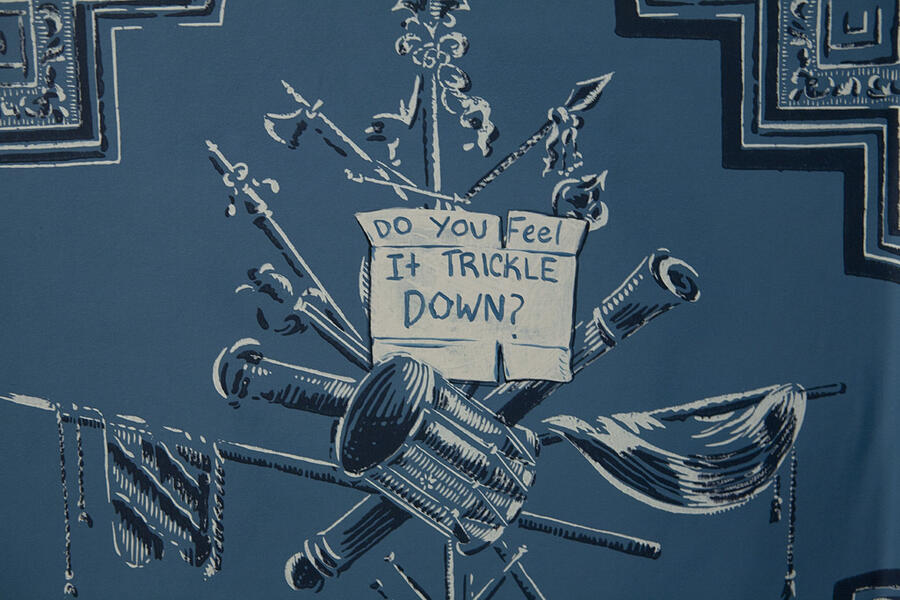 We the PeopleWe the People 2012 EXPO Chicago at the Navy Pier A solo booth presentation with the Contemporary Art Museum St. Louis We the People is an interactive installation in which the artist has painted slogans from recent Occupy Wall Street and Tea Party protests into reproduced Revolutionary War-era wallpaper. Visitors to the booth can record their own “protest” on a unique ceramic plate to be displayed during the fair. A custom-designed tea towel made exclusively for Expo Chicago both advertises the project and is exchanged with visitors in return for their contributions.
We the PeopleWe the People 2012 EXPO Chicago at the Navy Pier A solo booth presentation with the Contemporary Art Museum St. Louis We the People is an interactive installation in which the artist has painted slogans from recent Occupy Wall Street and Tea Party protests into reproduced Revolutionary War-era wallpaper. Visitors to the booth can record their own “protest” on a unique ceramic plate to be displayed during the fair. A custom-designed tea towel made exclusively for Expo Chicago both advertises the project and is exchanged with visitors in return for their contributions. -
 We the PeopleWe the People 2012 EXPO Chicago at the Navy Pier A solo booth presentation with the Contemporary Art Museum St. Louis We the People is an interactive installation in which the artist has painted slogans from recent Occupy Wall Street and Tea Party protests into reproduced Revolutionary War-era wallpaper. Visitors to the booth can record their own “protest” on a unique ceramic plate to be displayed during the fair. A custom-designed tea towel made exclusively for Expo Chicago both advertises the project and is exchanged with visitors in return for their contributions.
We the PeopleWe the People 2012 EXPO Chicago at the Navy Pier A solo booth presentation with the Contemporary Art Museum St. Louis We the People is an interactive installation in which the artist has painted slogans from recent Occupy Wall Street and Tea Party protests into reproduced Revolutionary War-era wallpaper. Visitors to the booth can record their own “protest” on a unique ceramic plate to be displayed during the fair. A custom-designed tea towel made exclusively for Expo Chicago both advertises the project and is exchanged with visitors in return for their contributions. -
 We the PeopleWe the People 2012 EXPO Chicago at the Navy Pier A solo booth presentation with the Contemporary Art Museum St. Louis We the People is an interactive installation in which the artist has painted slogans from recent Occupy Wall Street and Tea Party protests into reproduced Revolutionary War-era wallpaper. Visitors to the booth can record their own “protest” on a unique ceramic plate to be displayed during the fair. A custom-designed tea towel made exclusively for Expo Chicago both advertises the project and is exchanged with visitors in return for their contributions.
We the PeopleWe the People 2012 EXPO Chicago at the Navy Pier A solo booth presentation with the Contemporary Art Museum St. Louis We the People is an interactive installation in which the artist has painted slogans from recent Occupy Wall Street and Tea Party protests into reproduced Revolutionary War-era wallpaper. Visitors to the booth can record their own “protest” on a unique ceramic plate to be displayed during the fair. A custom-designed tea towel made exclusively for Expo Chicago both advertises the project and is exchanged with visitors in return for their contributions. -
 We the PeopleWe the People 2012 EXPO Chicago at the Navy Pier A solo booth presentation with the Contemporary Art Museum St. Louis We the People is an interactive installation in which the artist has painted slogans from recent Occupy Wall Street and Tea Party protests into reproduced Revolutionary War-era wallpaper. Visitors to the booth can record their own “protest” on a unique ceramic plate to be displayed during the fair. A custom-designed tea towel made exclusively for Expo Chicago both advertises the project and is exchanged with visitors in return for their contributions.
We the PeopleWe the People 2012 EXPO Chicago at the Navy Pier A solo booth presentation with the Contemporary Art Museum St. Louis We the People is an interactive installation in which the artist has painted slogans from recent Occupy Wall Street and Tea Party protests into reproduced Revolutionary War-era wallpaper. Visitors to the booth can record their own “protest” on a unique ceramic plate to be displayed during the fair. A custom-designed tea towel made exclusively for Expo Chicago both advertises the project and is exchanged with visitors in return for their contributions.










